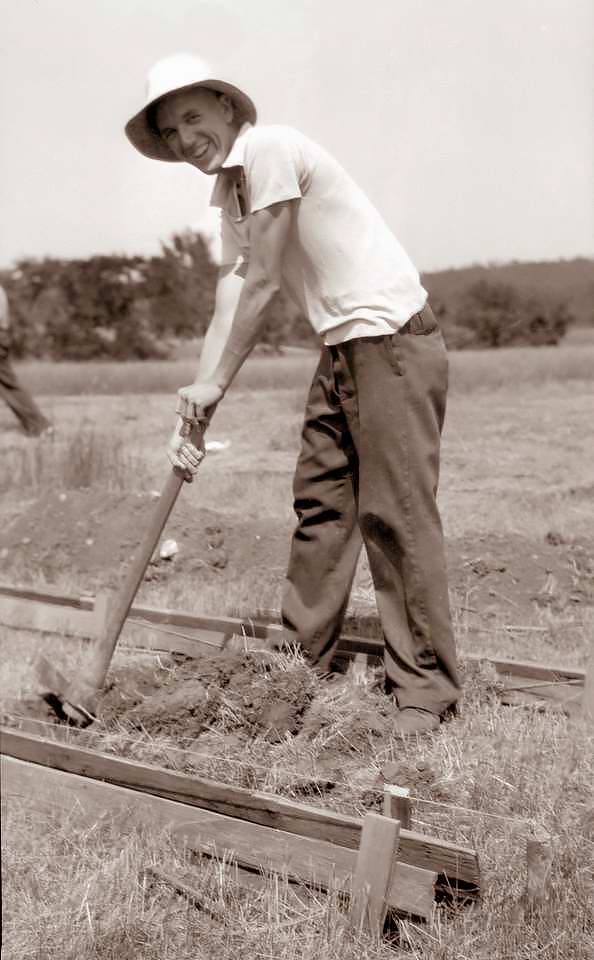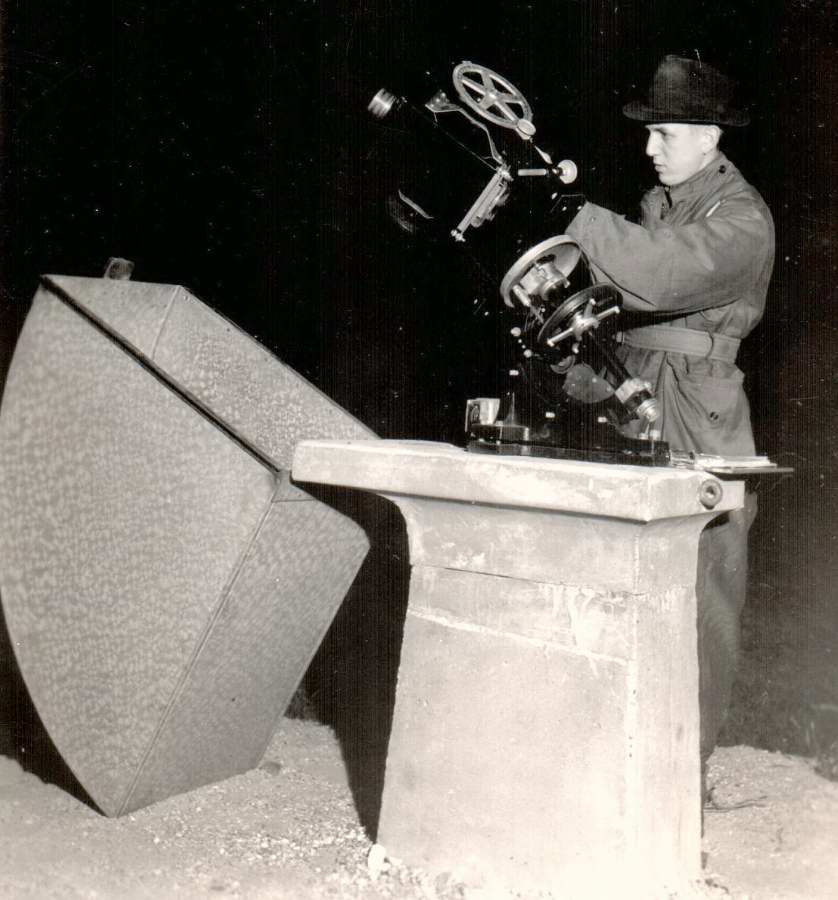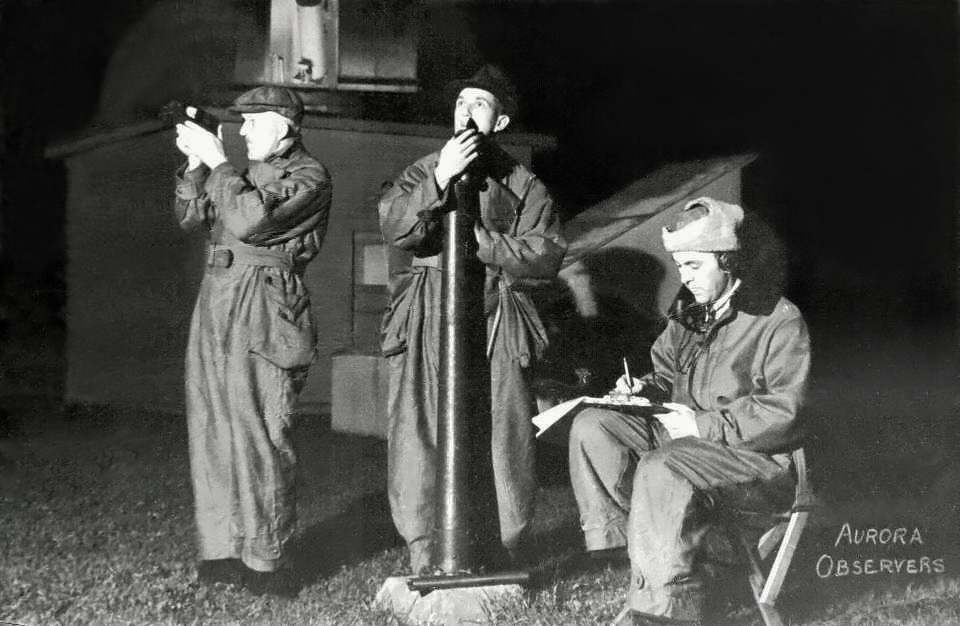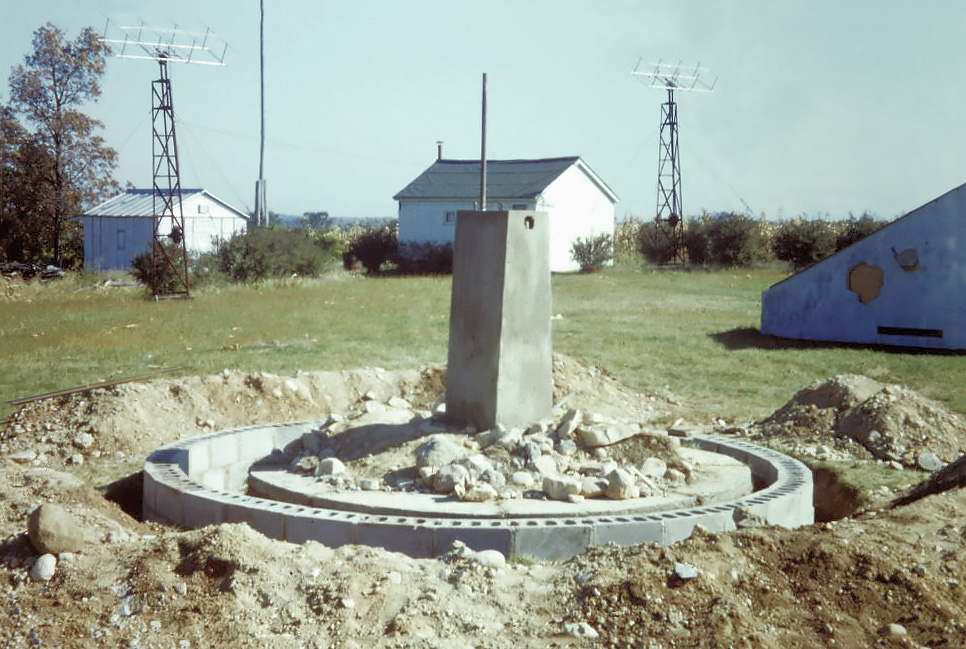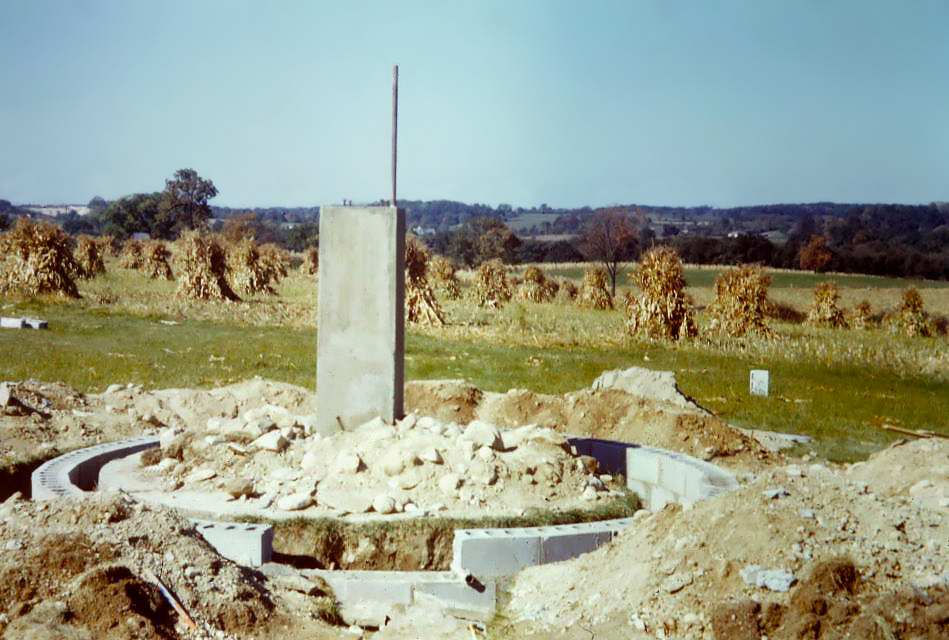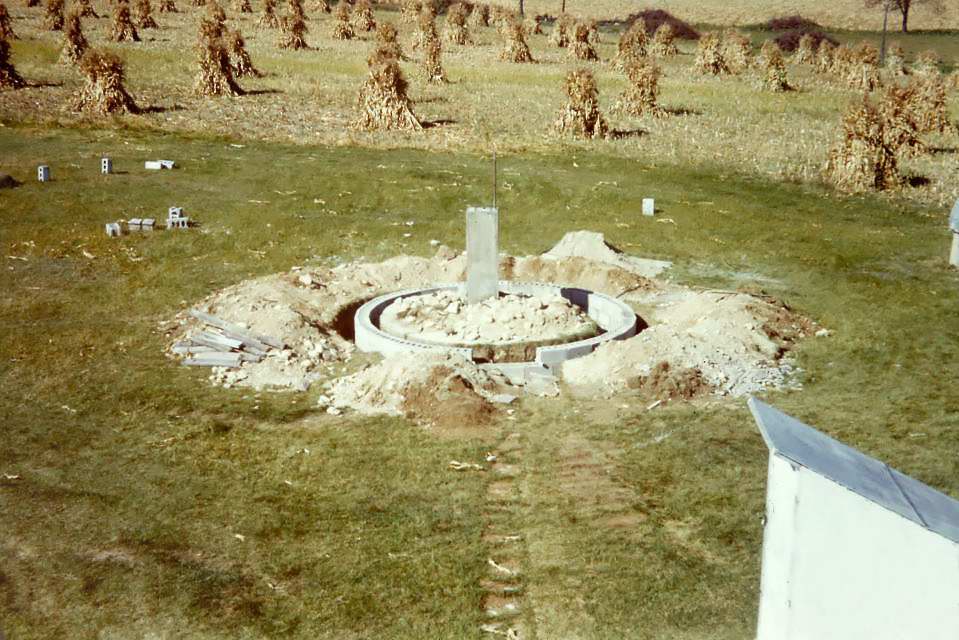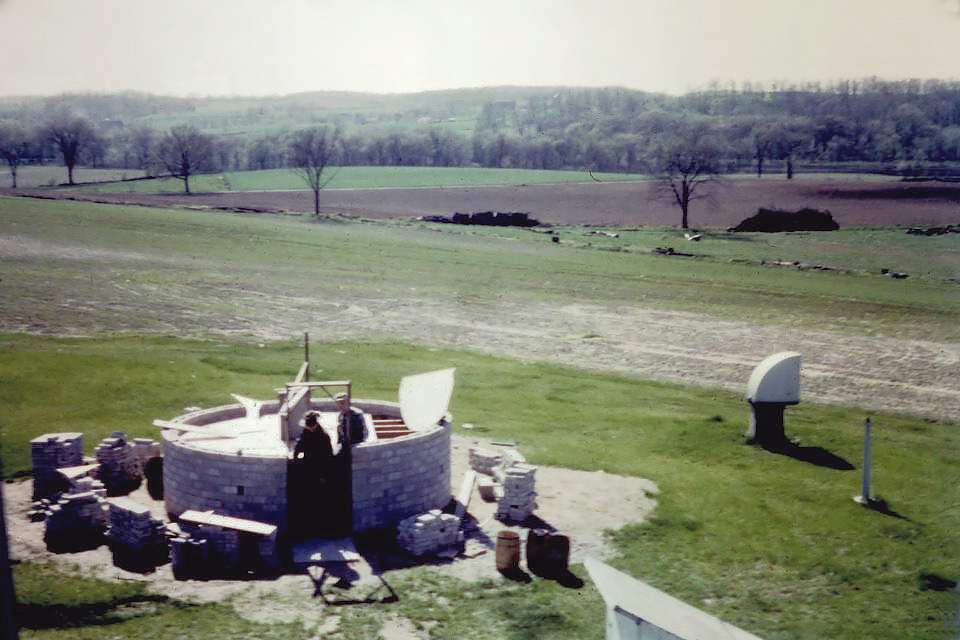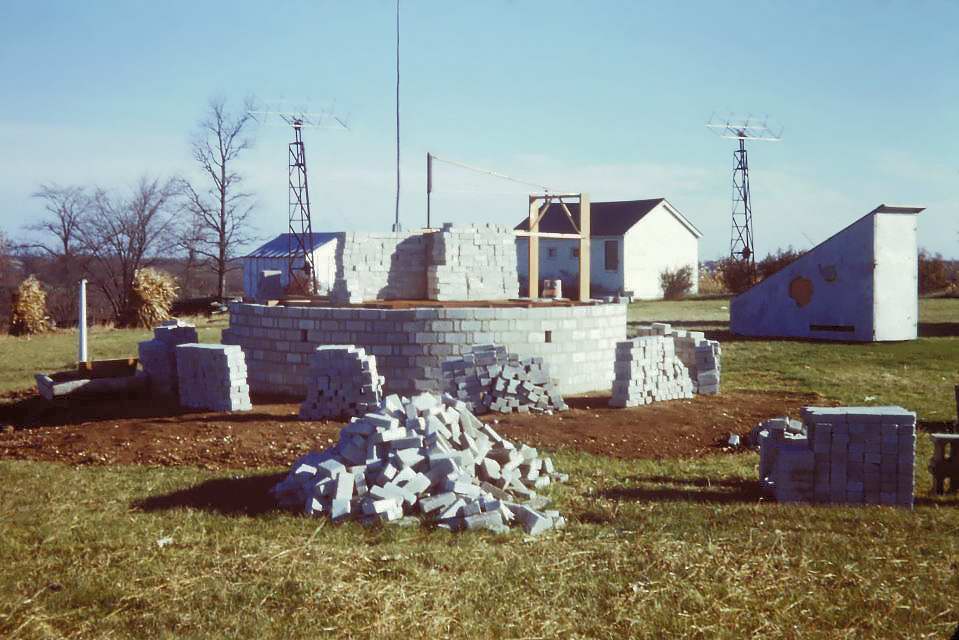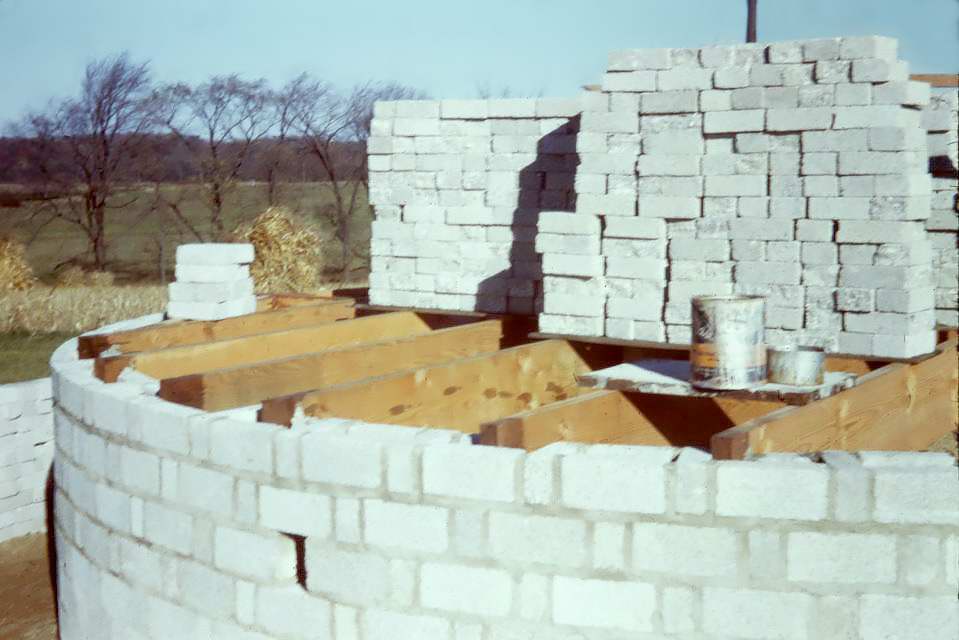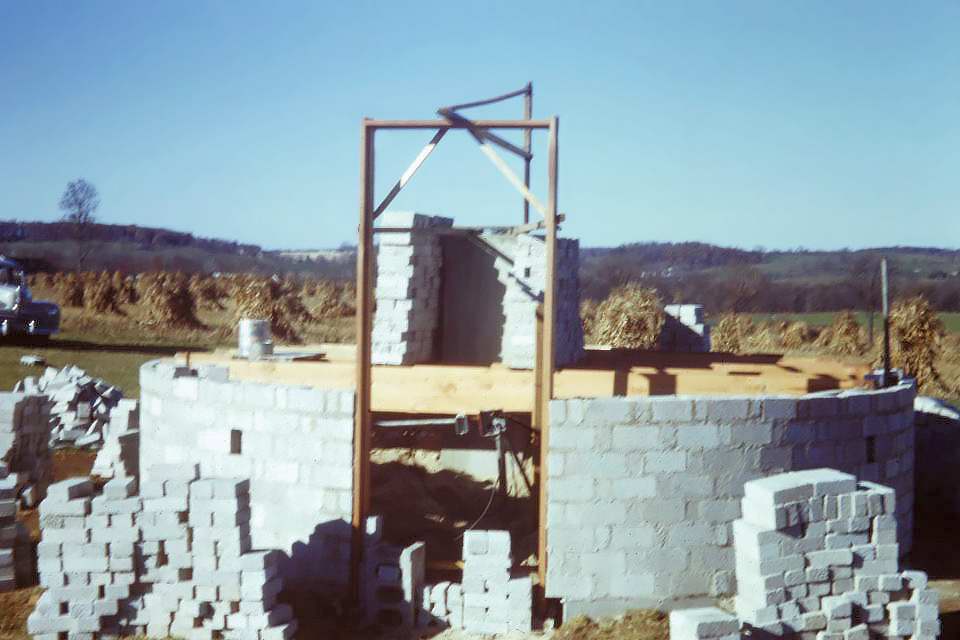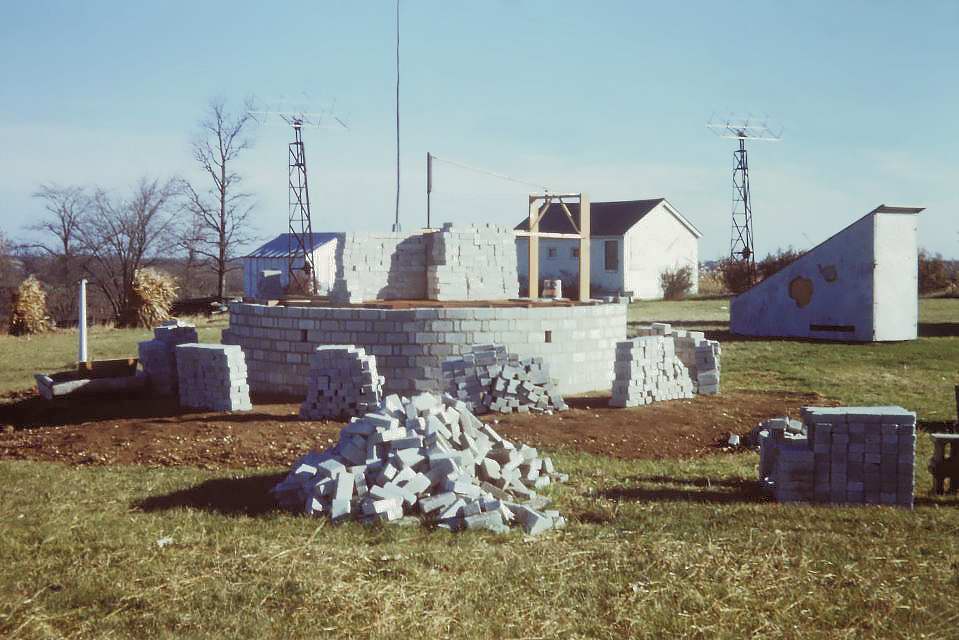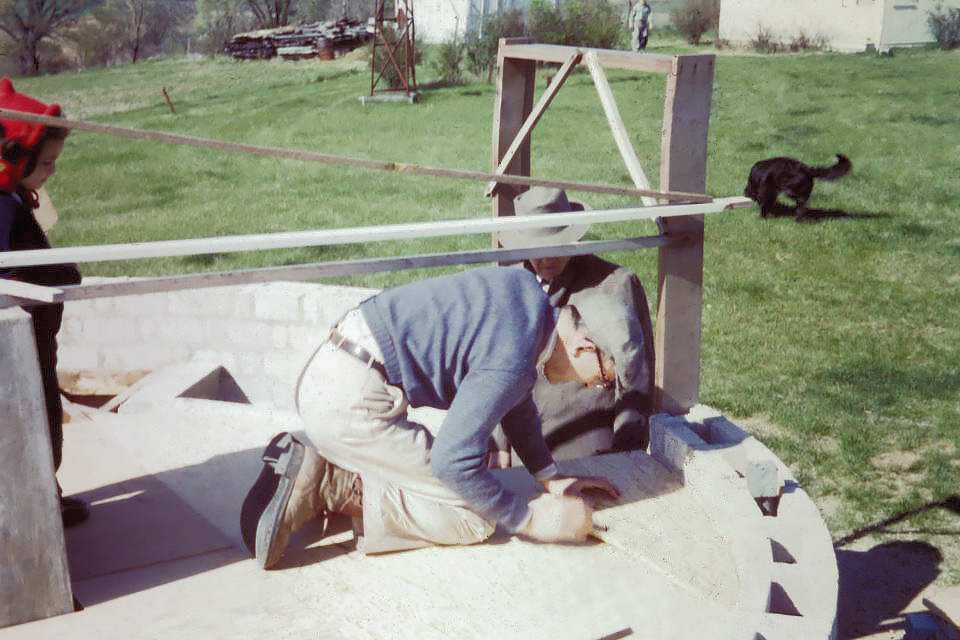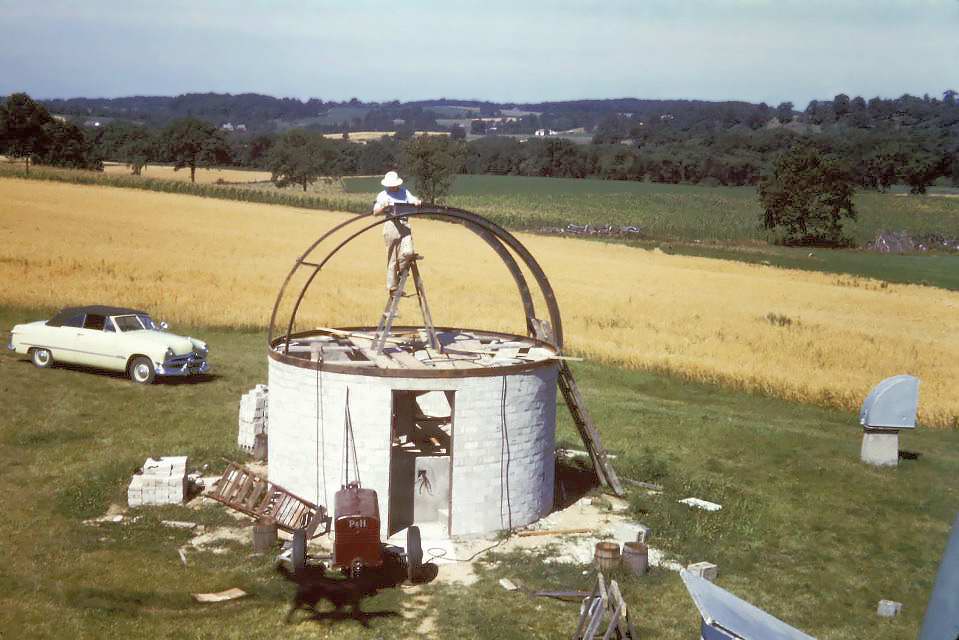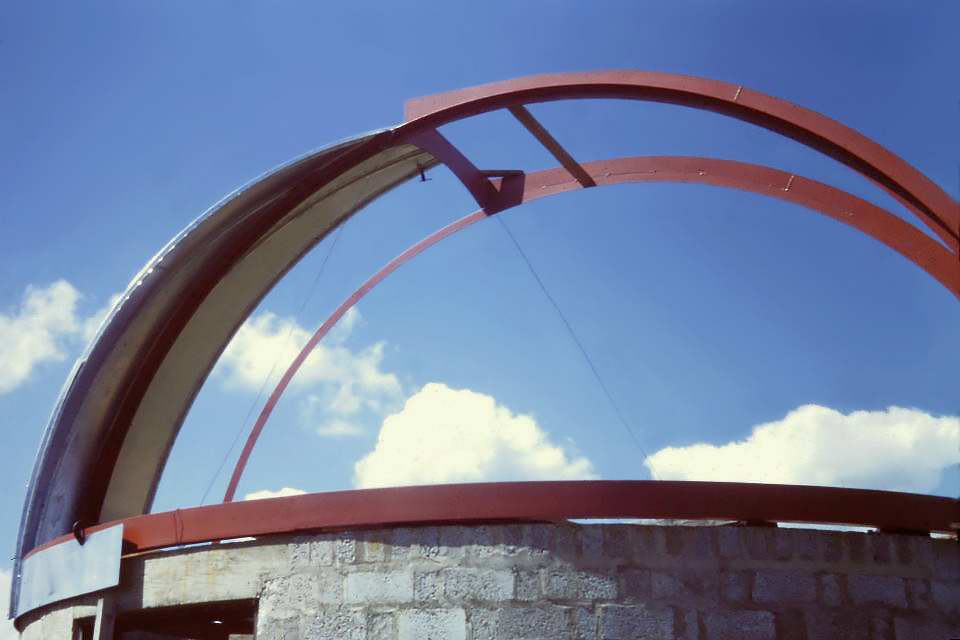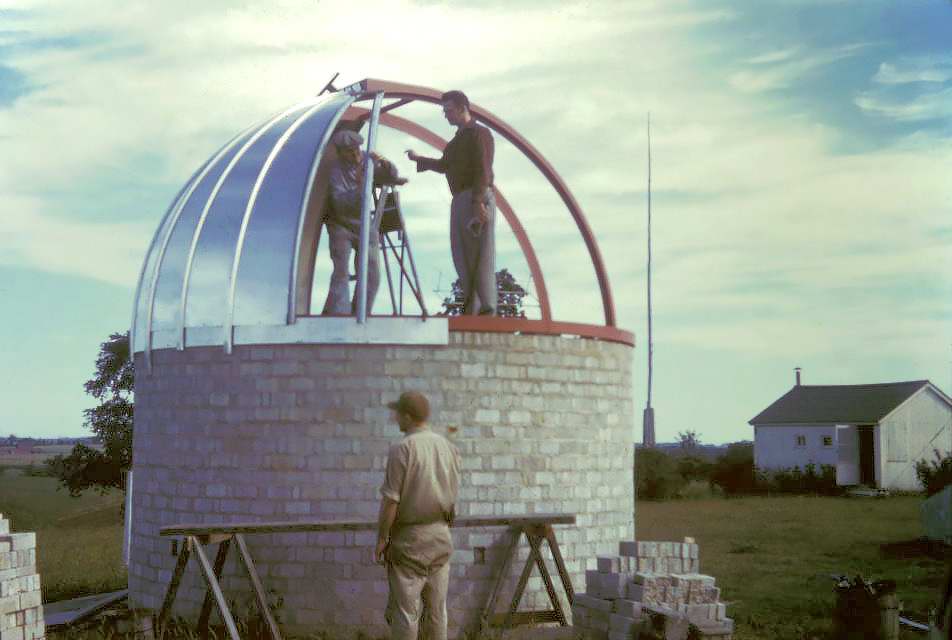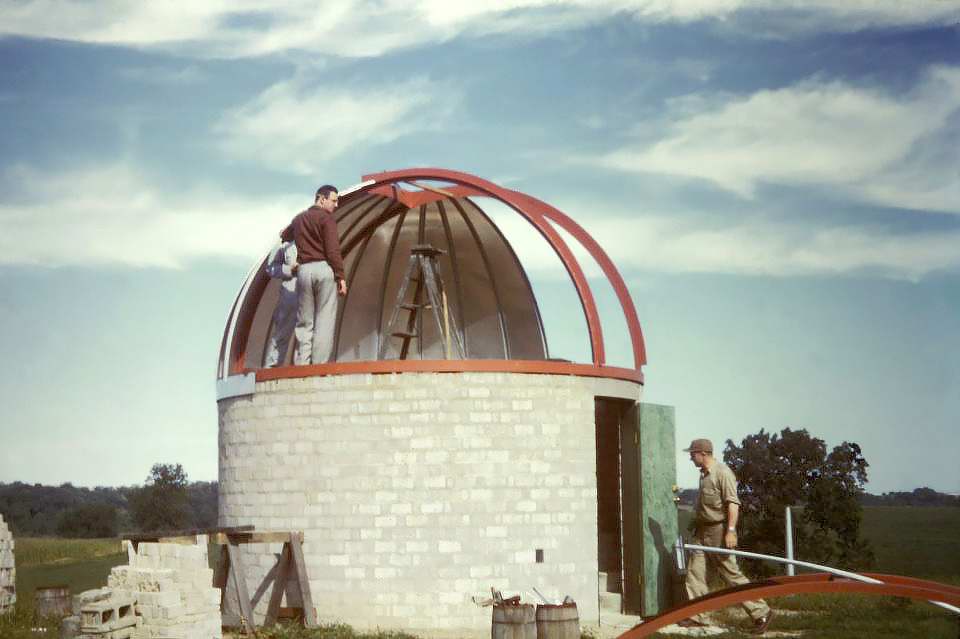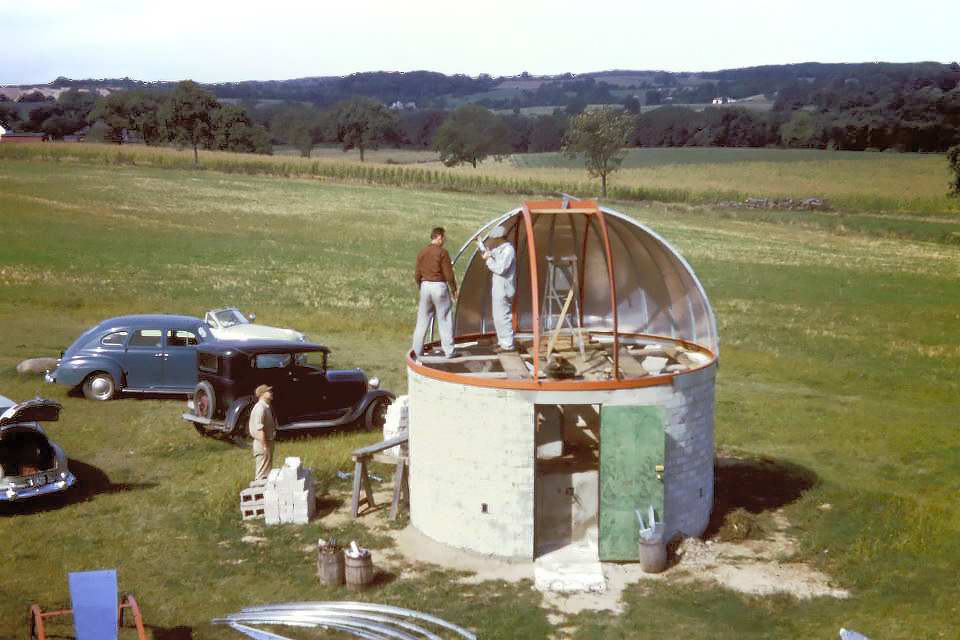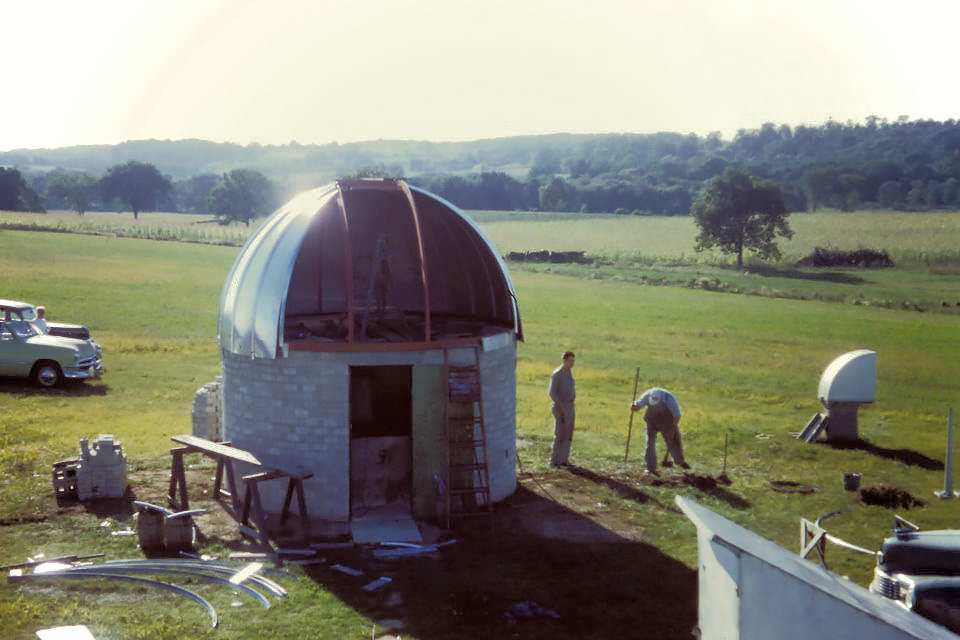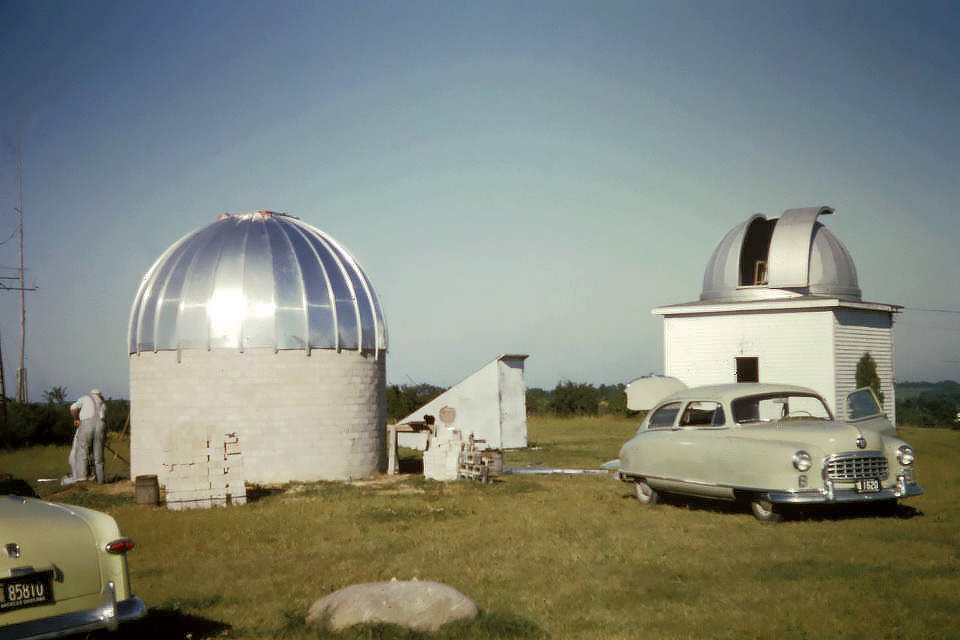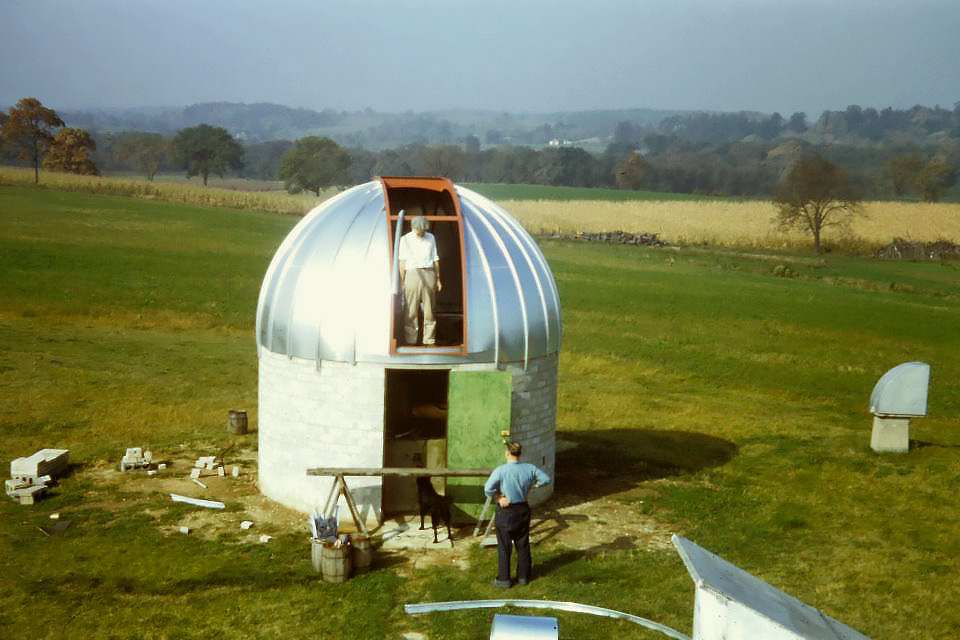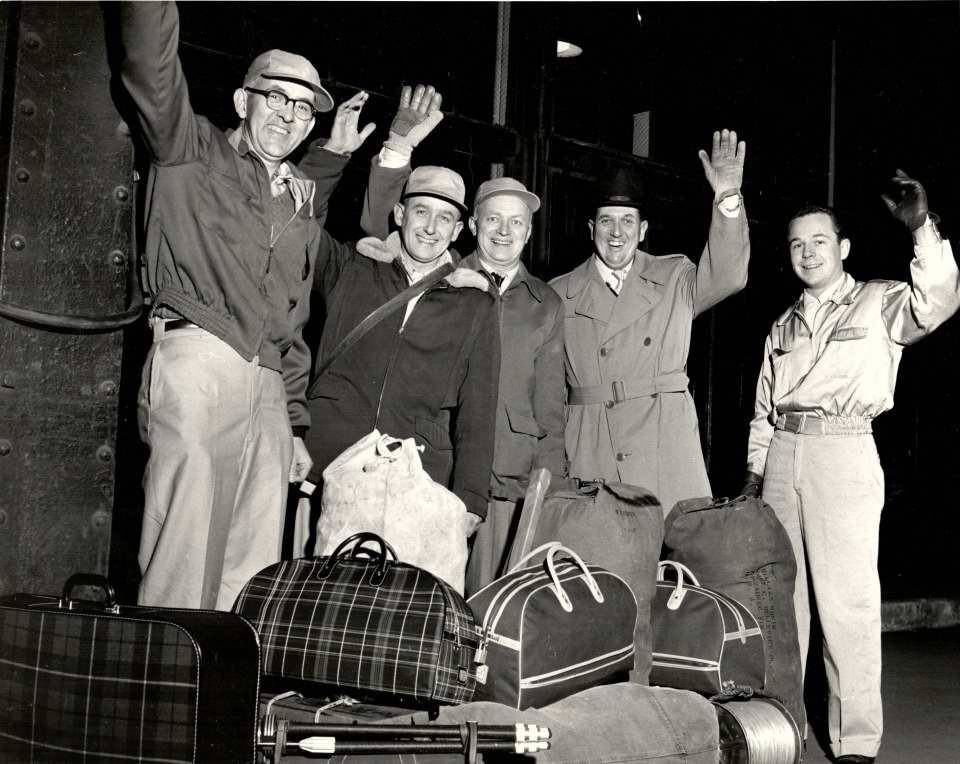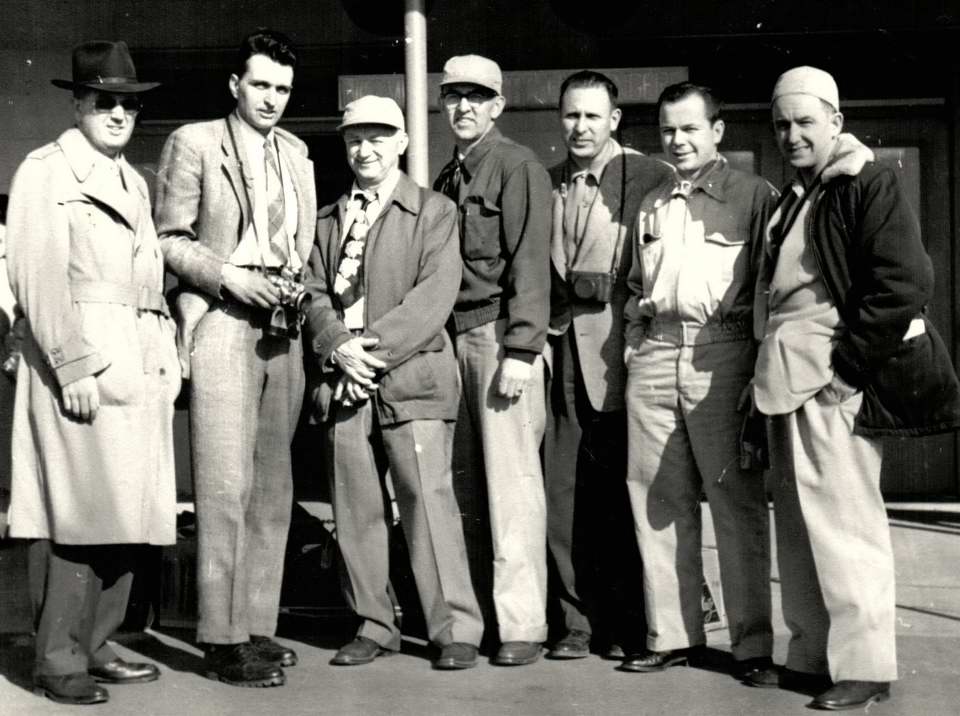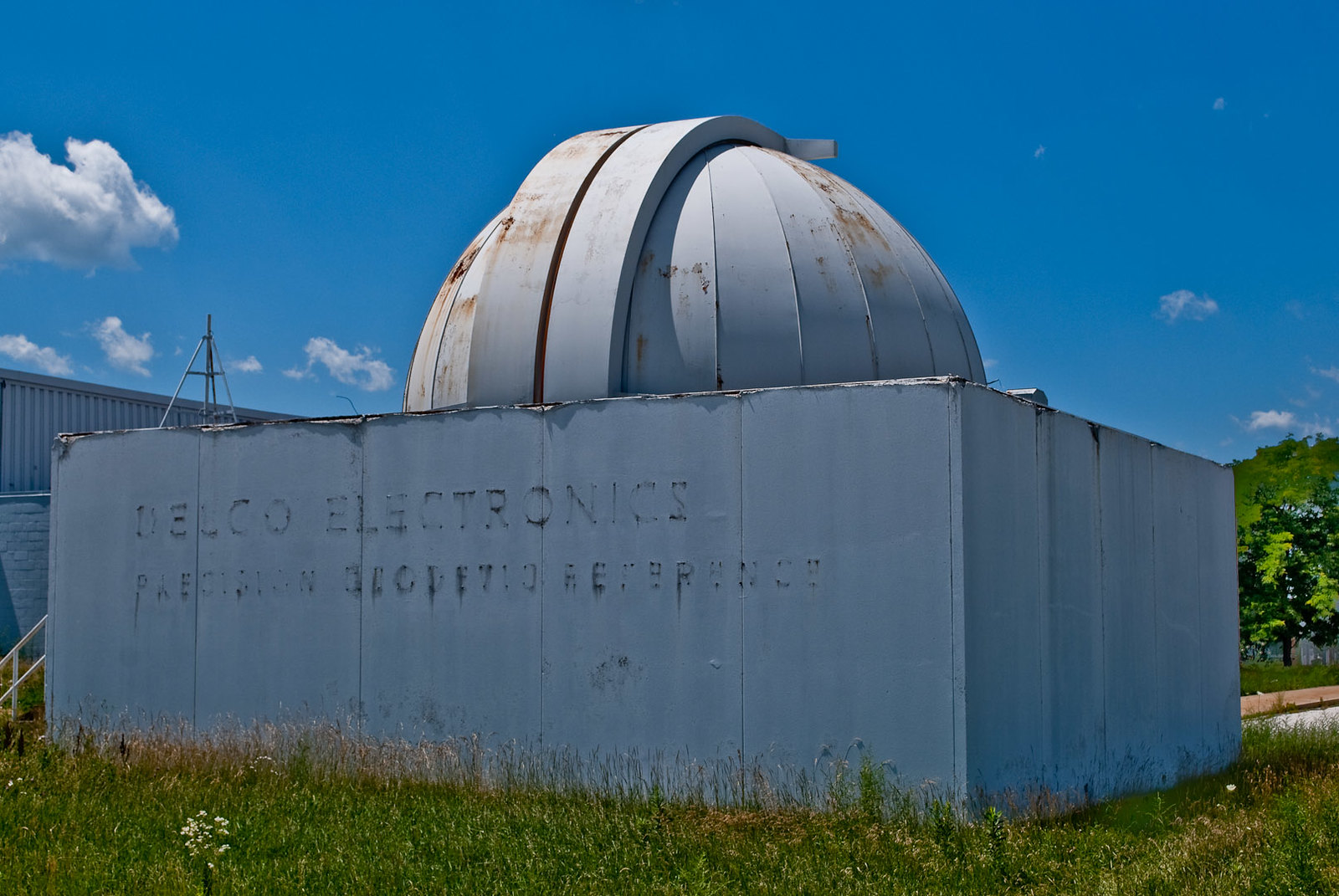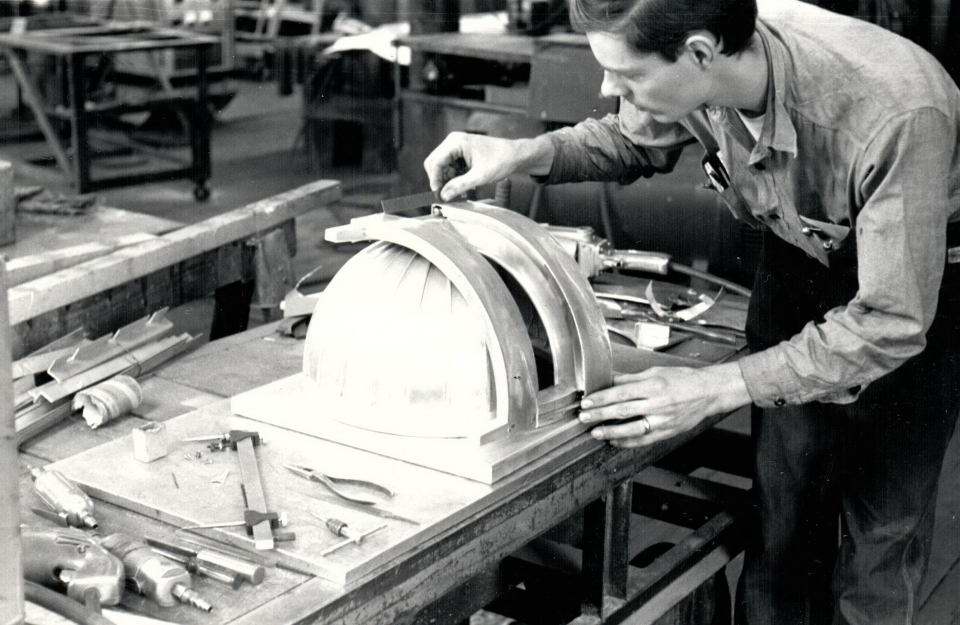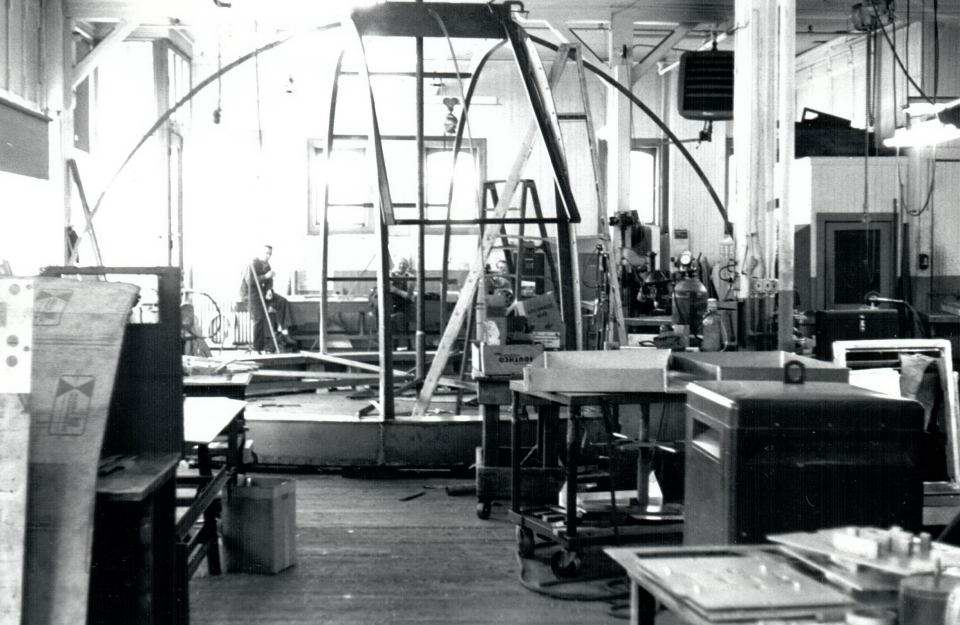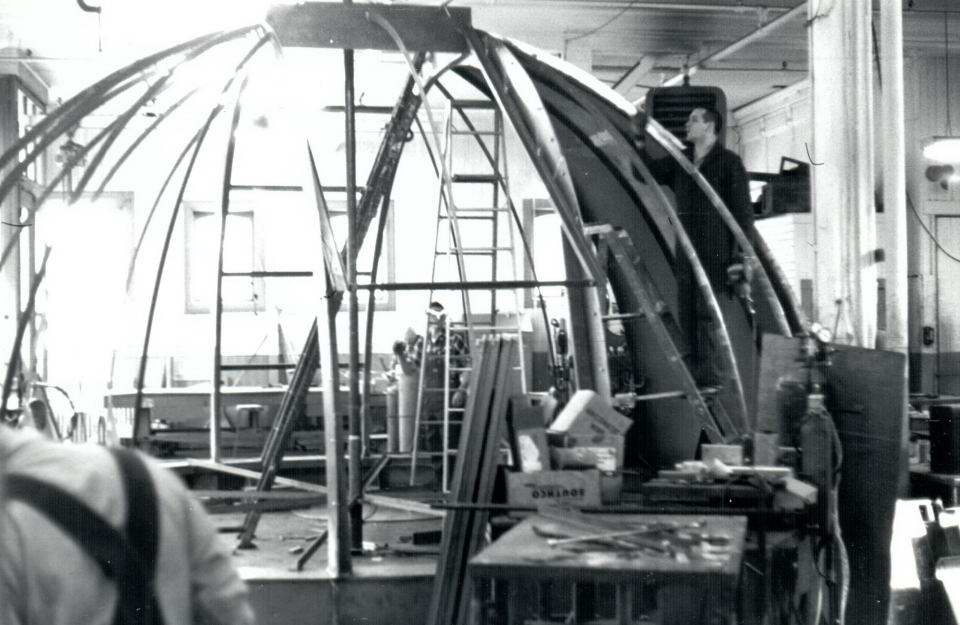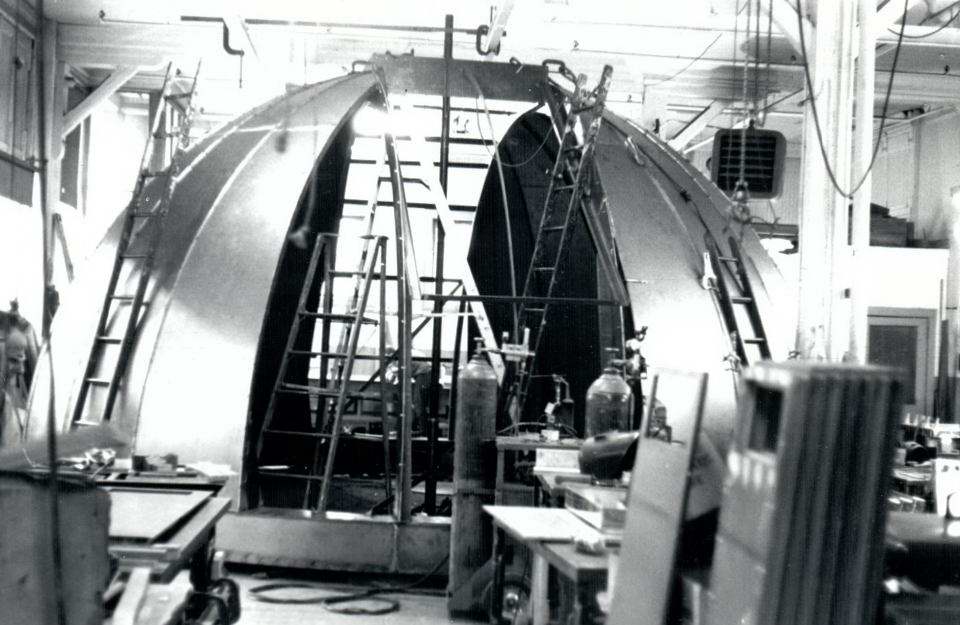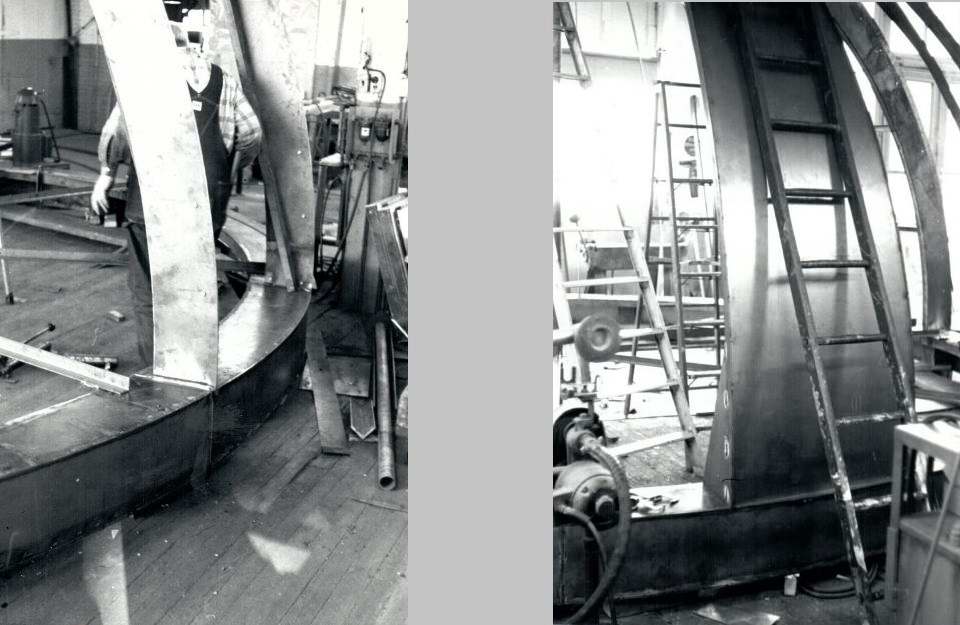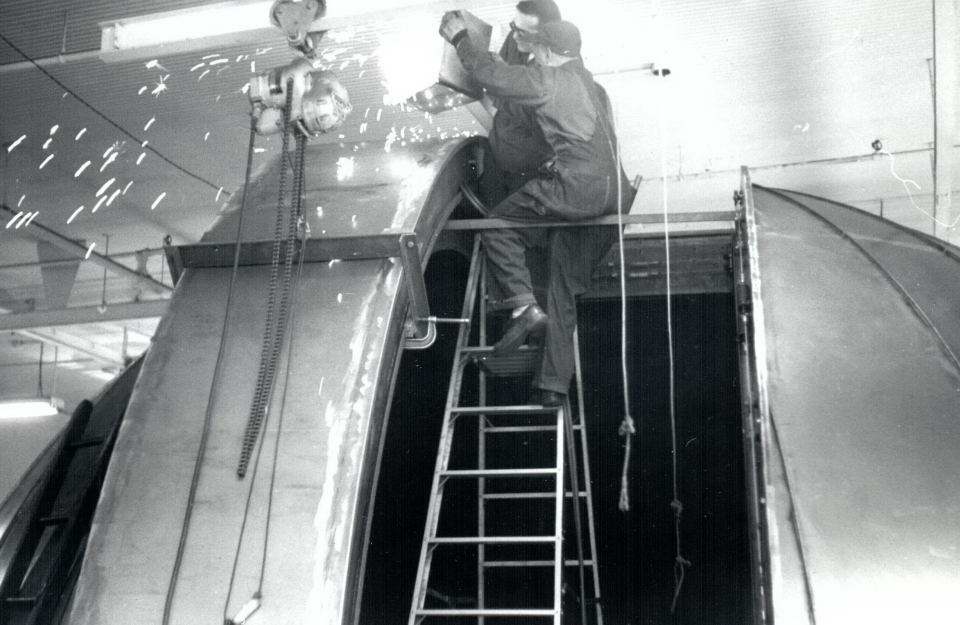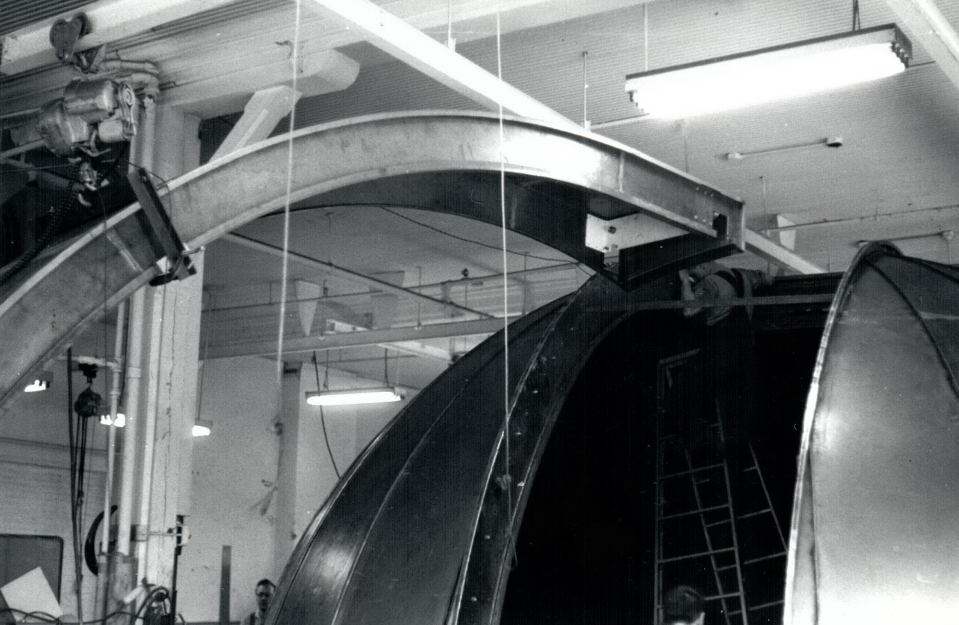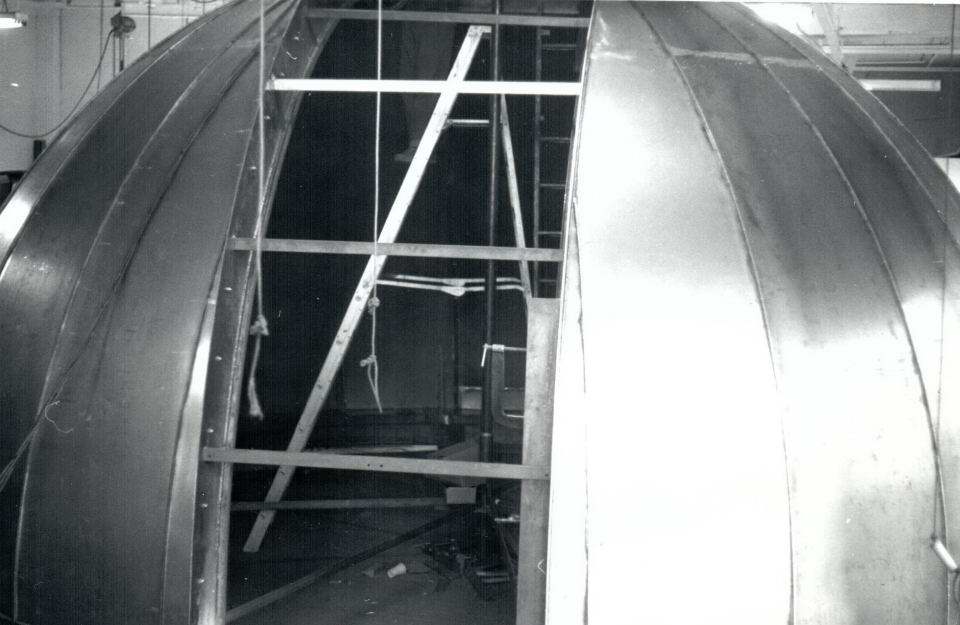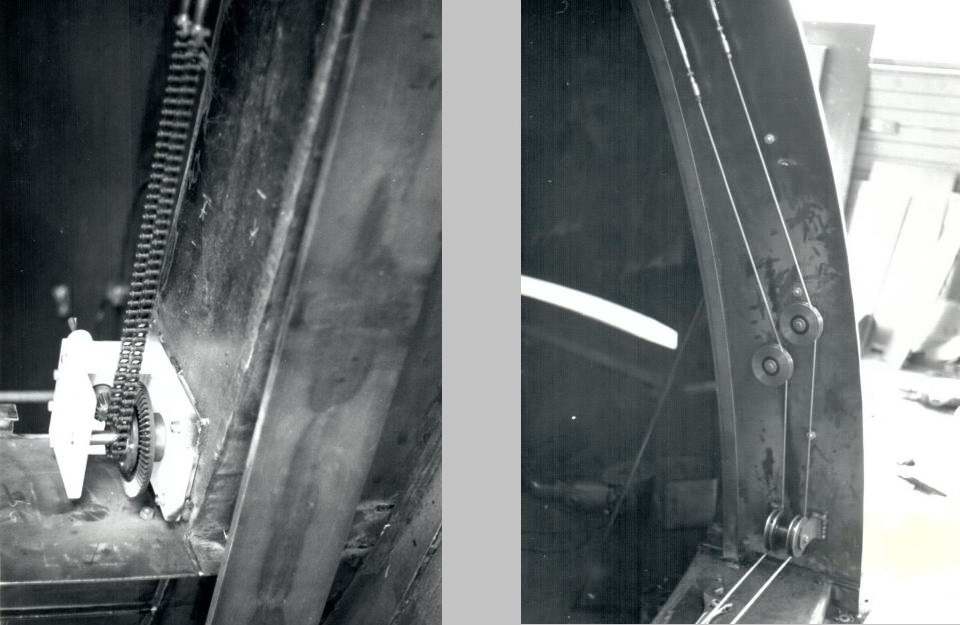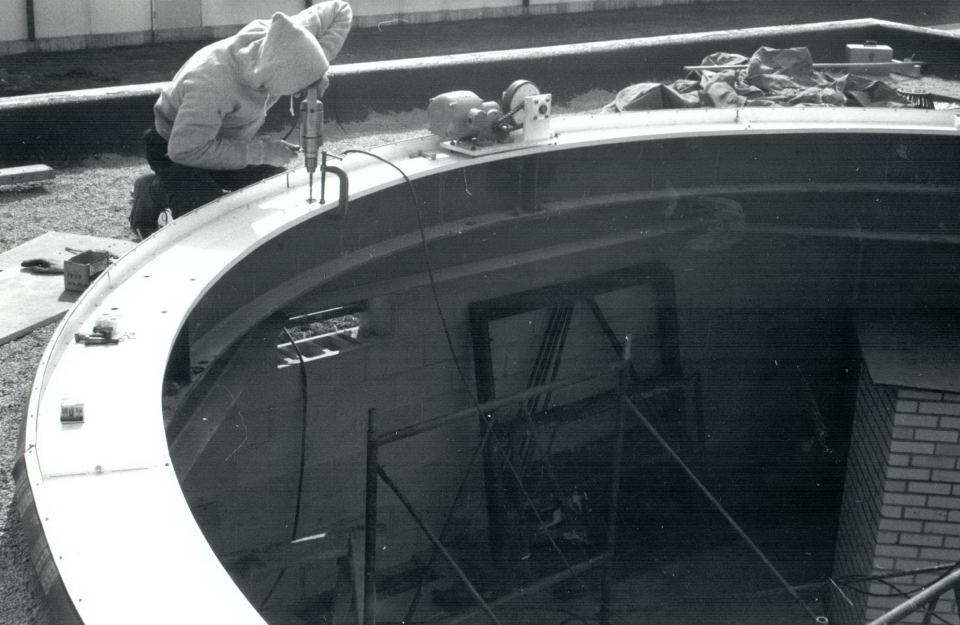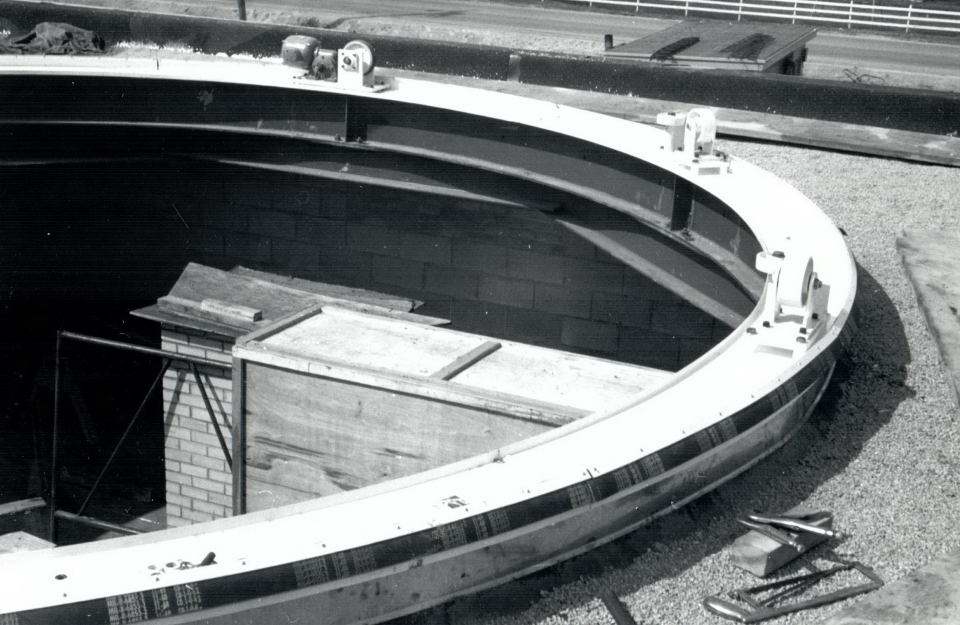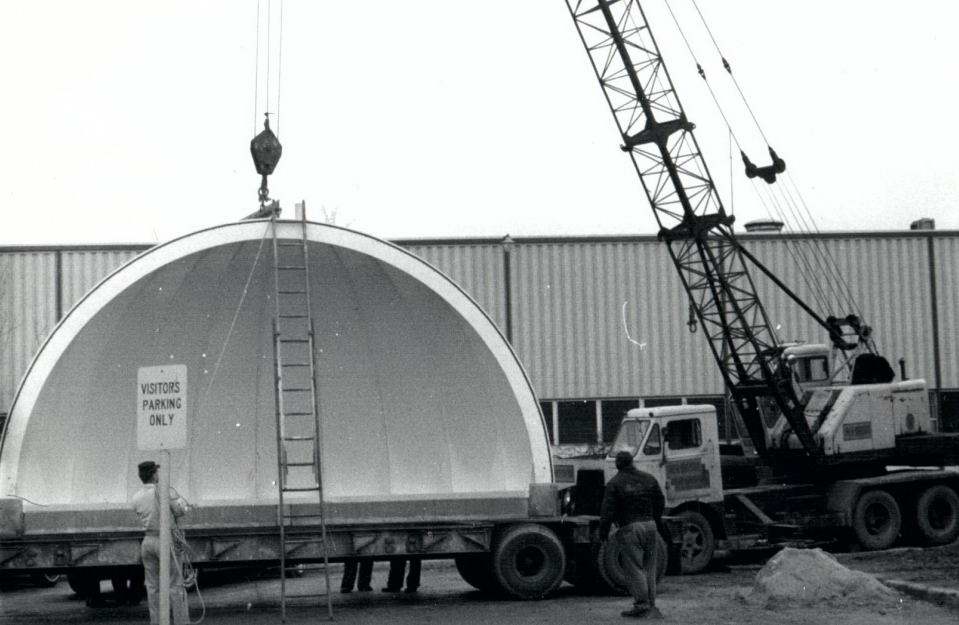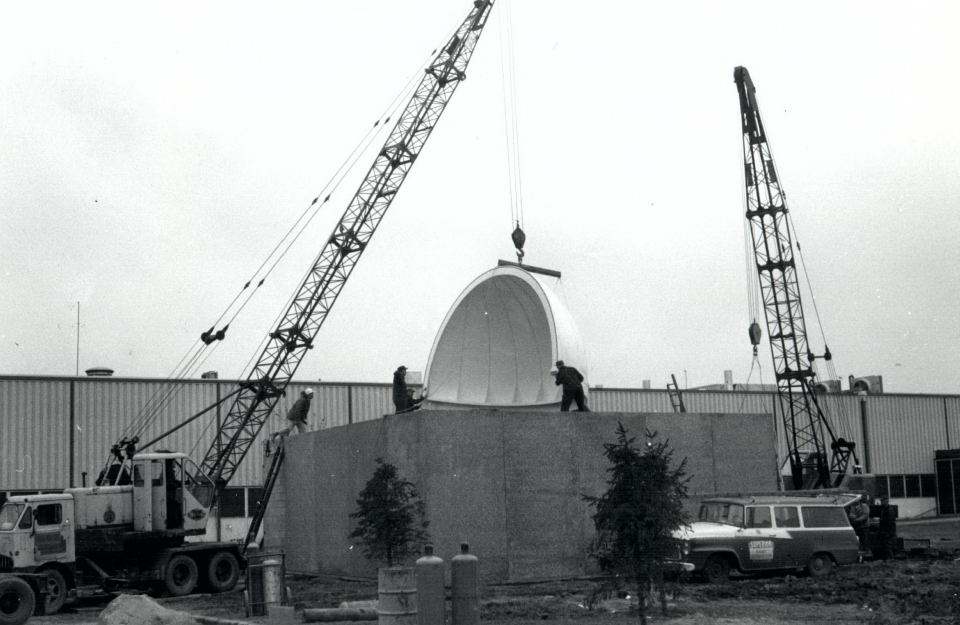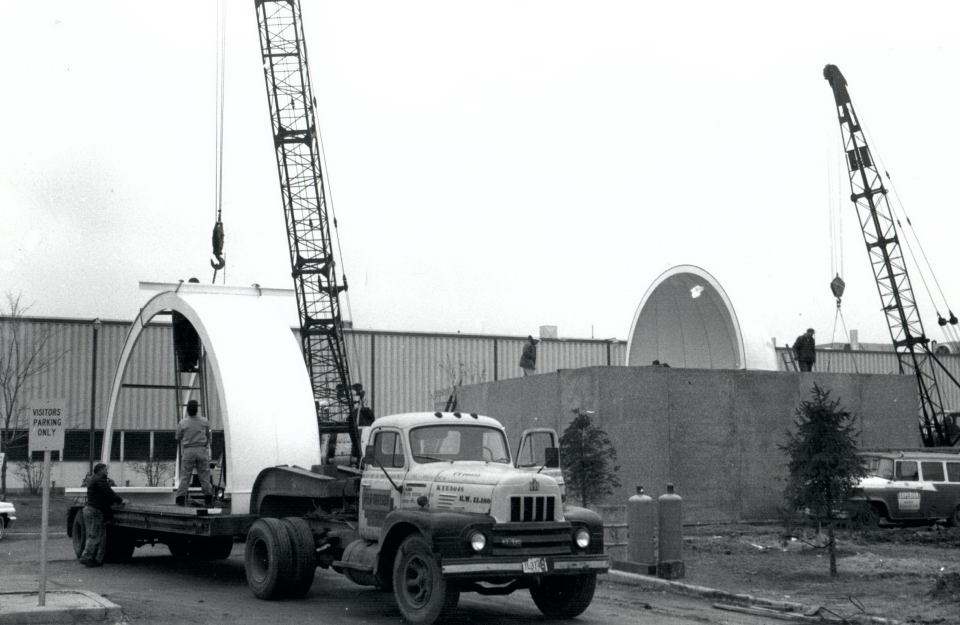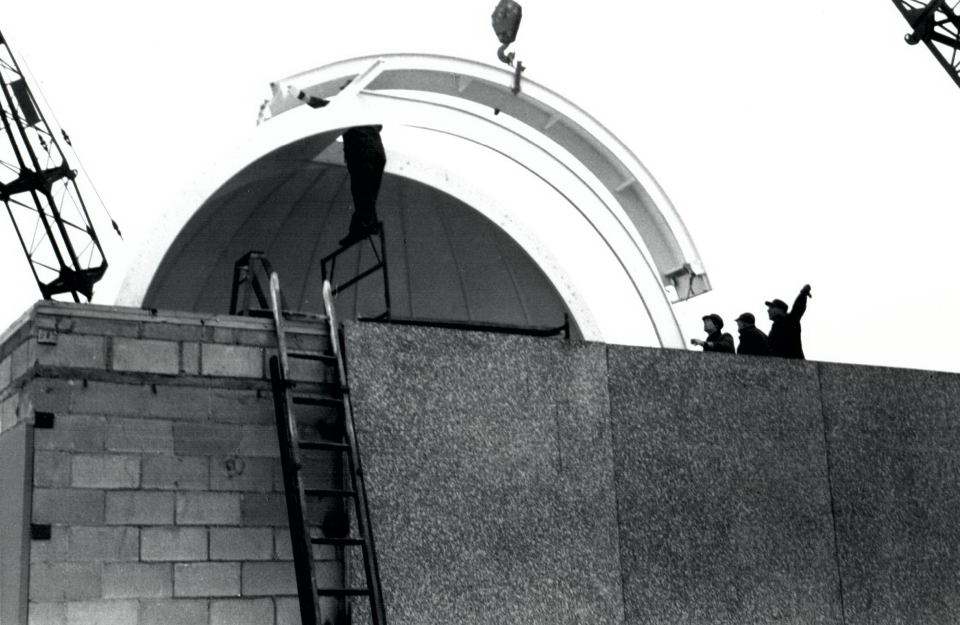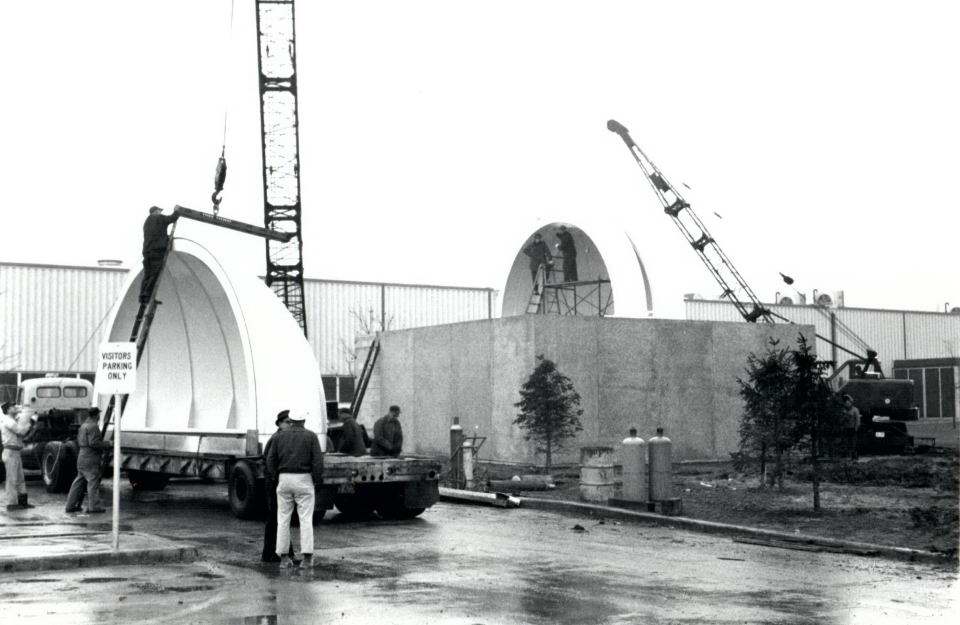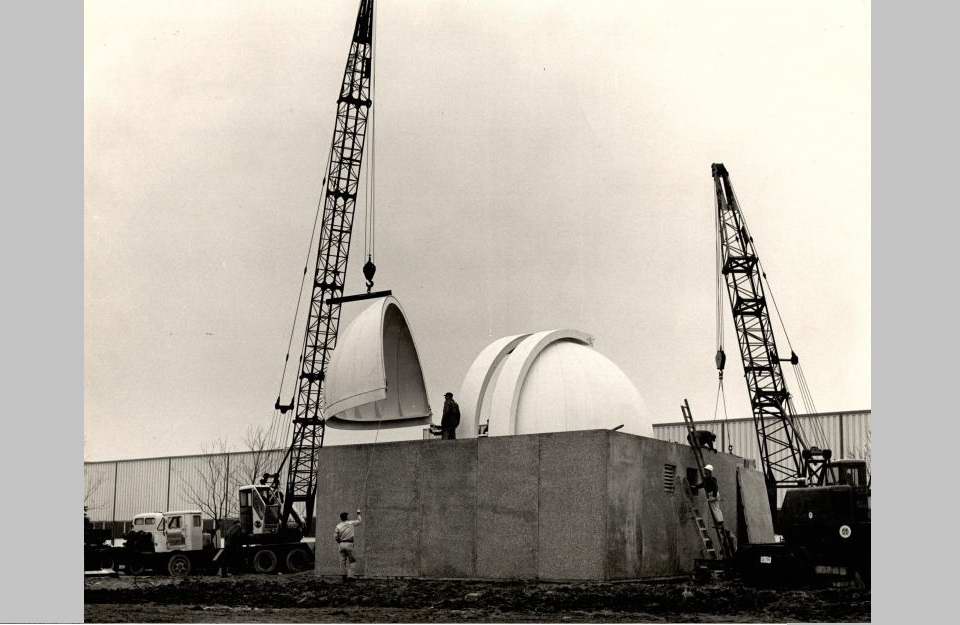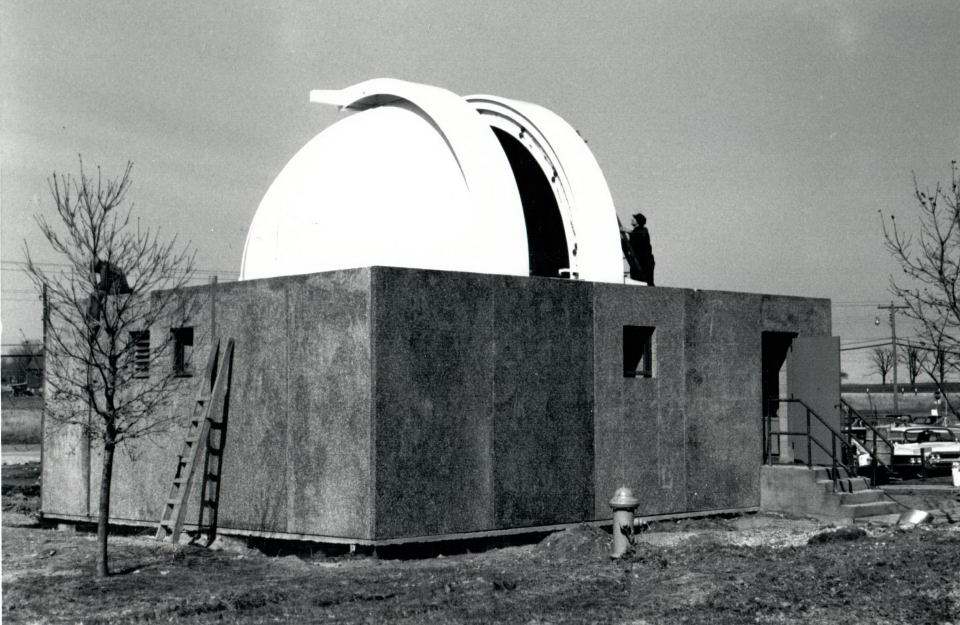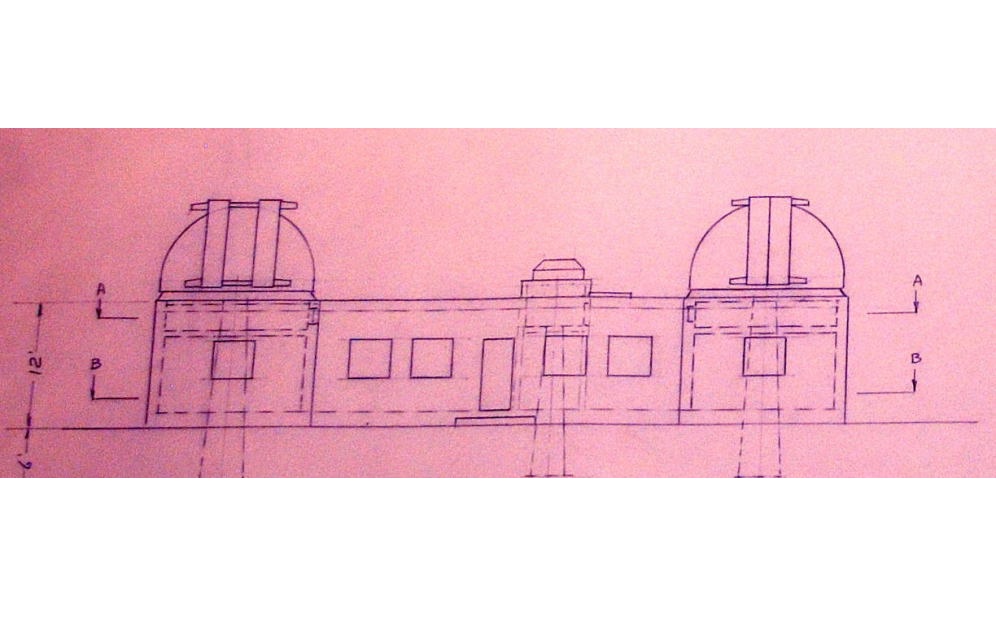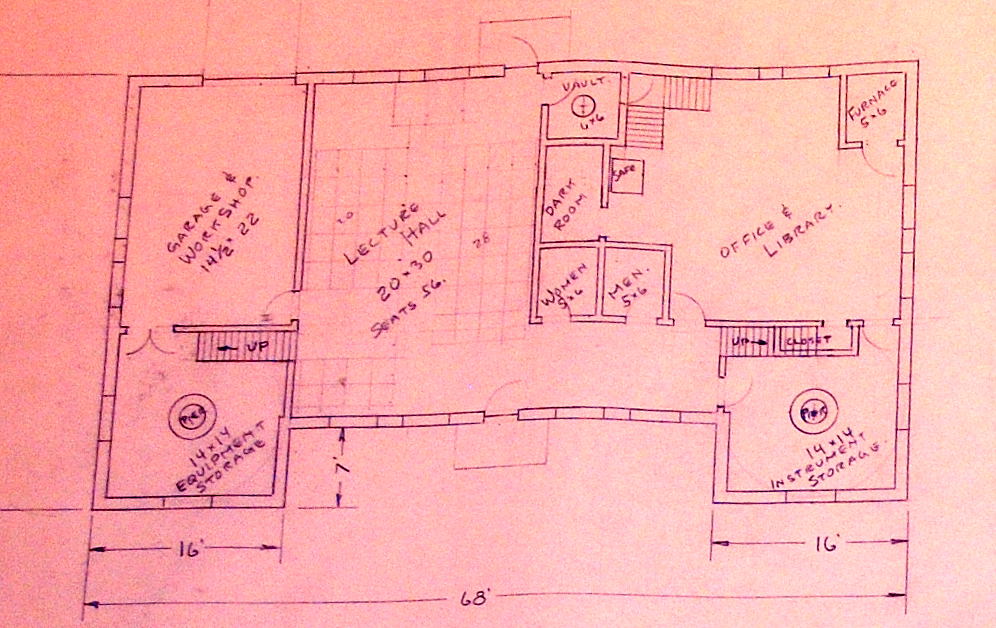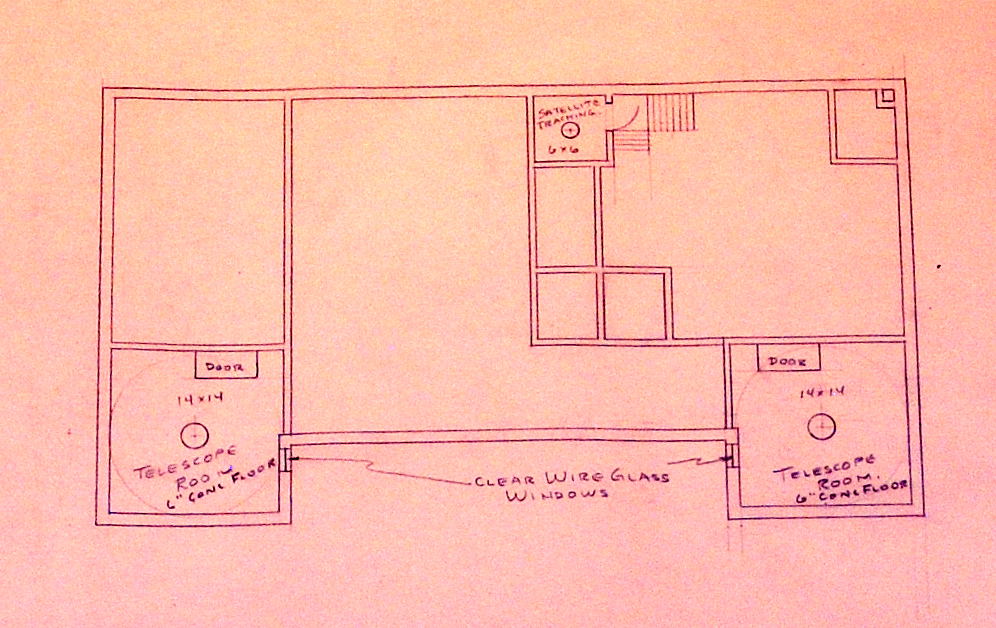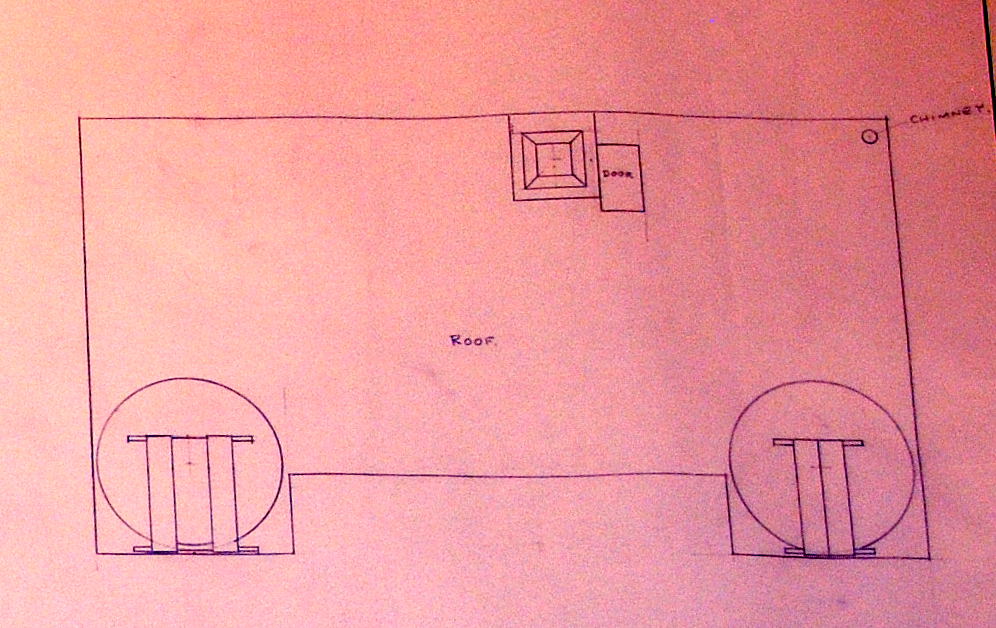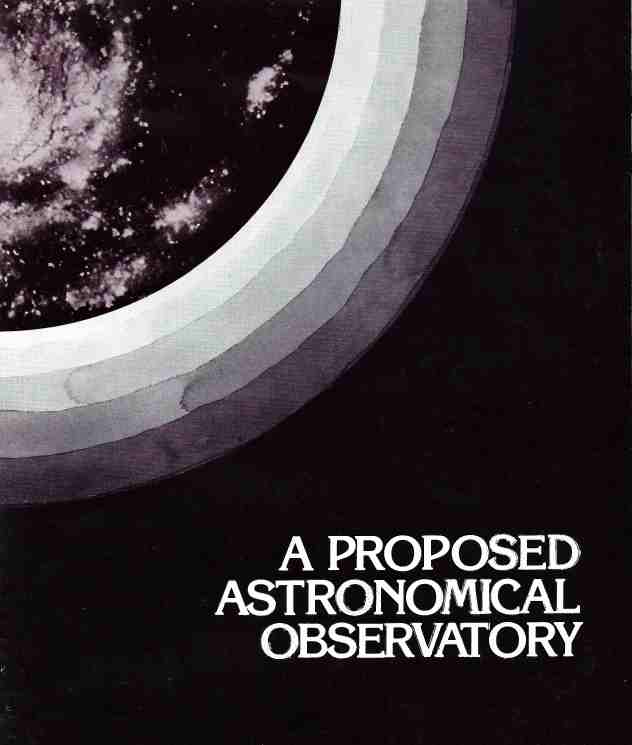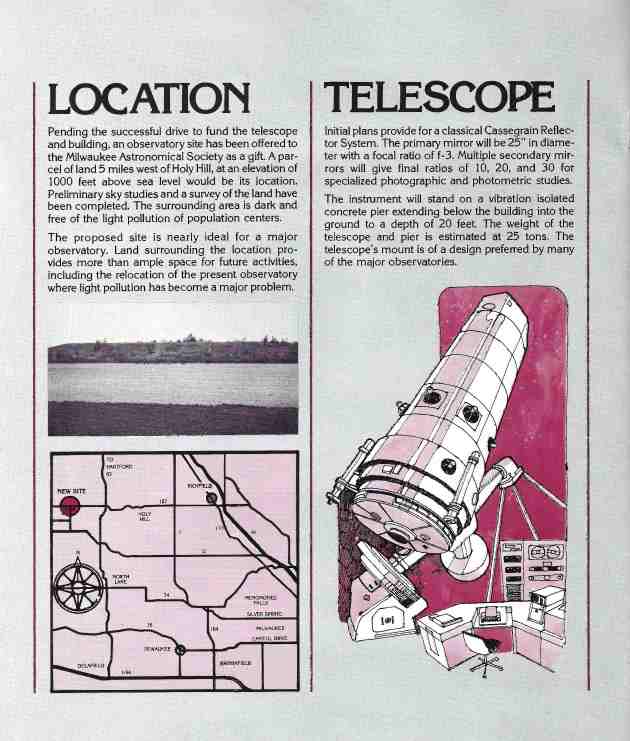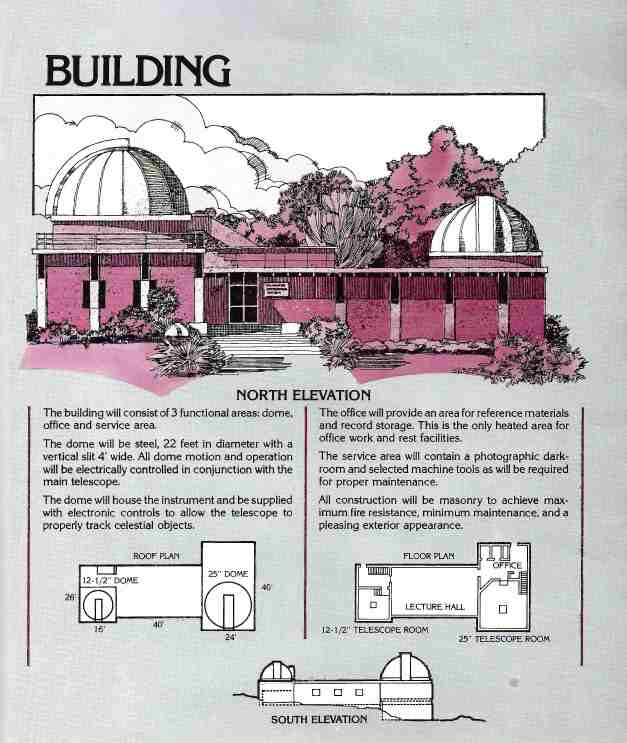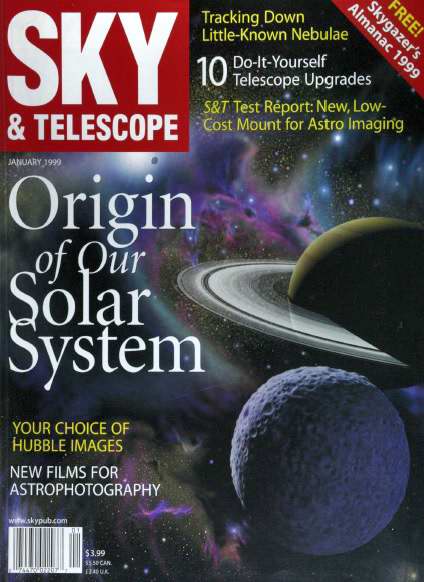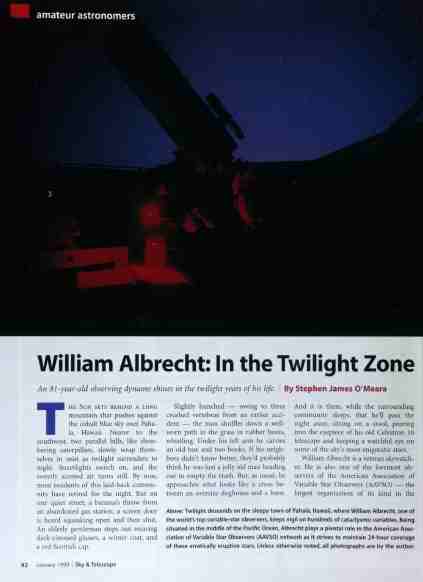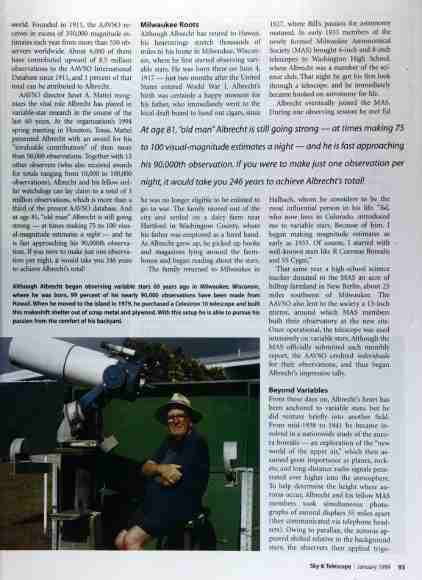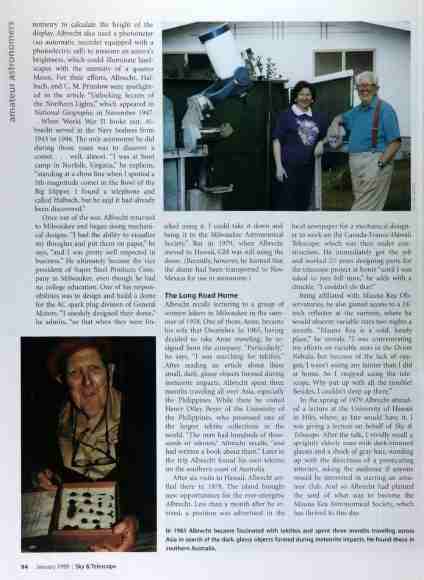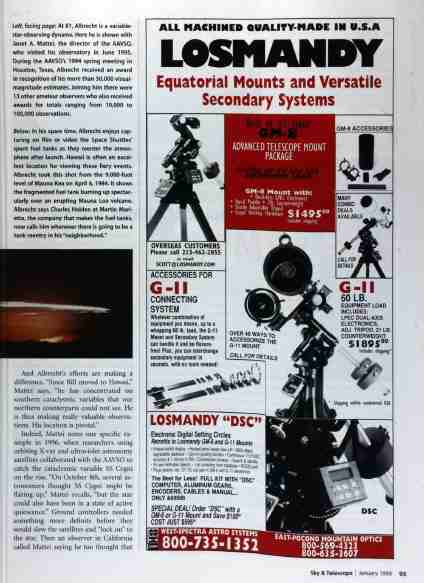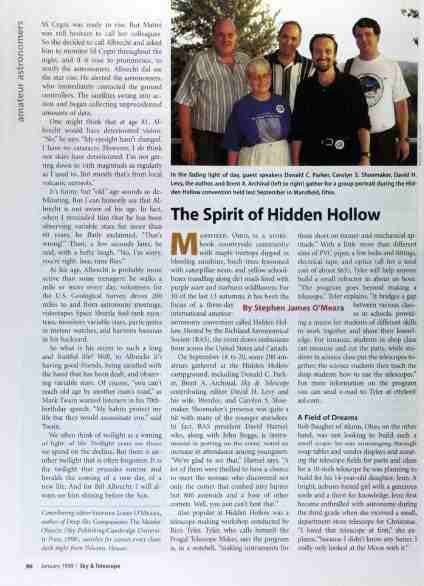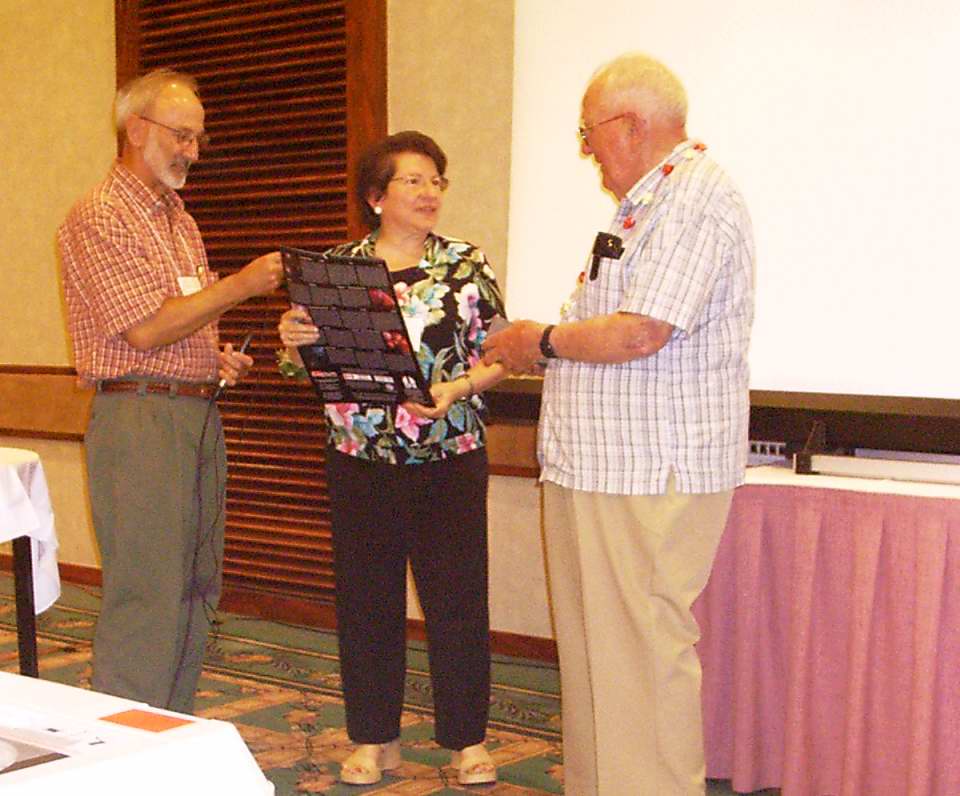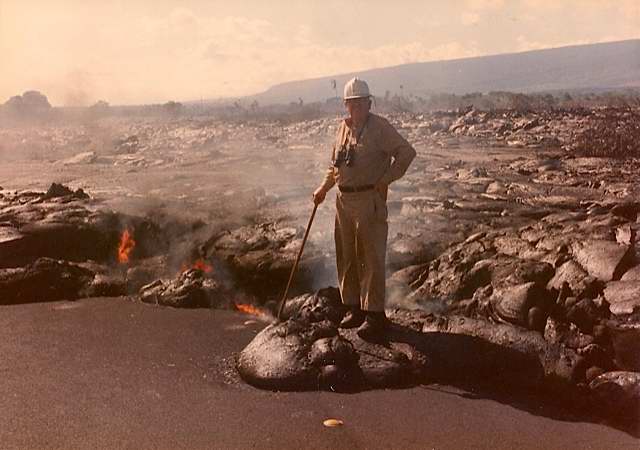Bill Albrecht
1917-2009
A long time Milwaukee Astronomical Society member, William (Bill) Albrecht, born on June 4, 1917, passed away on April 25, 2009 at the age of 91. He was a member of the MAS for 76 years! He is also one of the most significant members in our society's history.
In early 1933, members of the newly formed Milwaukee Astronomical Society brought 6-inch and 8-inch telescopes to Washington High School where Albrecht was a member of their science club. That evening he got his opportunity to look through a telescope and was hooked for life. Later that year he joined the MAS as a junior auxilary member. There he met Ed Halbach and began a friendship that lasted over 75 years. Halbach immediately introduced Albrecht to variable star observing.
Albrecht was involved in the construction of many projects at the observatory for many years. He used to joke, "Sometimes, astronomy was something that was done with a shovel and a wheelbarrow." His first project was the construction of the C-Shed footings in July of 1937. A week later he started working on the Armfield Observatory.
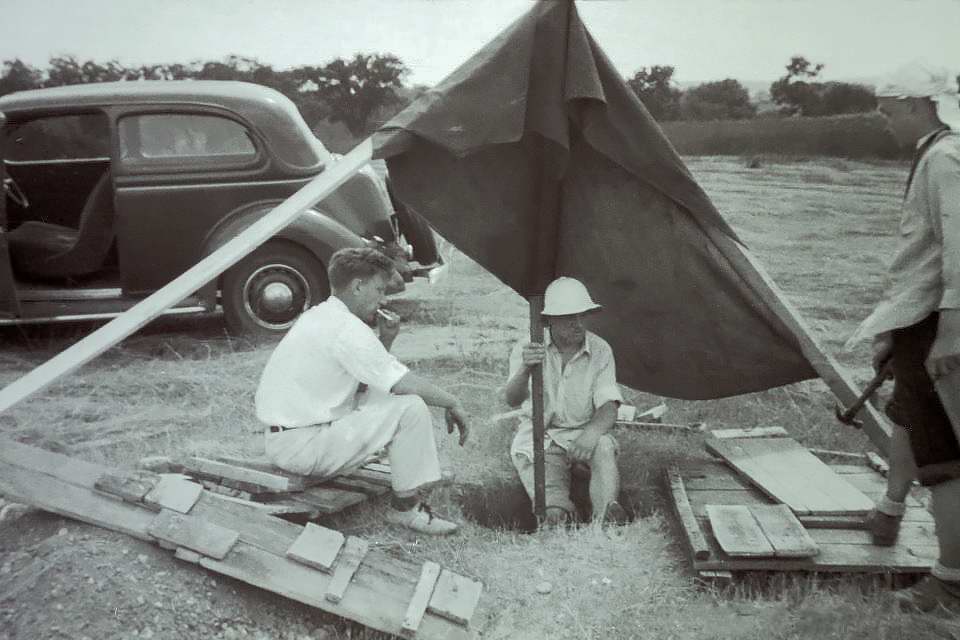
1937 Observatory construction. Digging the footer for the telescope pier. Left: Luverne Armfield, Center: Bill Albrecht, Right: Unknown.
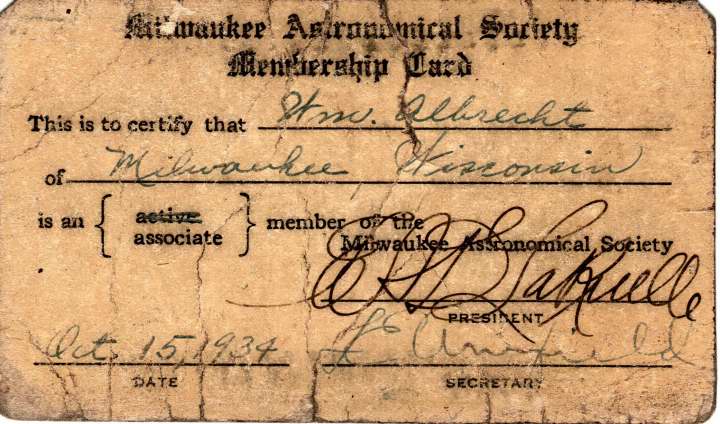 From mid-1938 to 1941 the club became involved in a nationwide study of the aurora borealis. This was an exploration of the
"new world of the upper air." This assumed great importance as planes, rockets, and long-distance radio signals
penetrated every higher into the atmosphere. The National Geographic Society gave to the MAS a pair of
Kodak f/2 cameras for this work. The MAS took simultaneous photos of aurora displays 35 miles apart while
in radio contact for coordination.) This allowed a parallax to be calculated and a height determination made.
From mid-1938 to 1941 the club became involved in a nationwide study of the aurora borealis. This was an exploration of the
"new world of the upper air." This assumed great importance as planes, rockets, and long-distance radio signals
penetrated every higher into the atmosphere. The National Geographic Society gave to the MAS a pair of
Kodak f/2 cameras for this work. The MAS took simultaneous photos of aurora displays 35 miles apart while
in radio contact for coordination.) This allowed a parallax to be calculated and a height determination made.
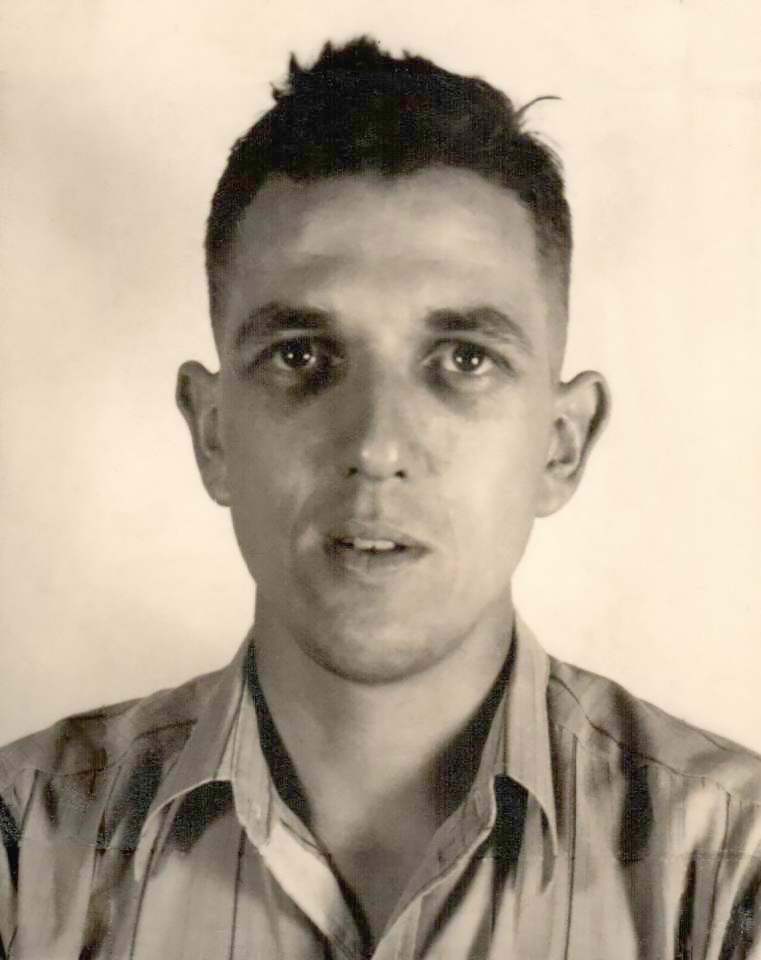 Albrecht served in the
US Navy Seabees from 1943 to 1946 when he did almost no astronomy. However, he almost discovered a comet
in bootcamp in 1943 when he spotted one (about 5th magnitude) in the bowl of the big dipper. He found a telephone and called Ed Halbach,
but then sadly found out it had already been discovered.
As he was a talented designer as well as
The A and B domes along with the MAS portascopes are among the many projects he was
involved in. Much of the mount on Z scope is based on designs Bill made shortly after the mirror blank was donated.
Albrecht served in the
US Navy Seabees from 1943 to 1946 when he did almost no astronomy. However, he almost discovered a comet
in bootcamp in 1943 when he spotted one (about 5th magnitude) in the bowl of the big dipper. He found a telephone and called Ed Halbach,
but then sadly found out it had already been discovered.
As he was a talented designer as well as
The A and B domes along with the MAS portascopes are among the many projects he was
involved in. Much of the mount on Z scope is based on designs Bill made shortly after the mirror blank was donated.
After serving in the Navy, Albrecht returned to Milwaukee and began doing mechanical designs. First employed by Allis-Chalmers, he then went to Super Steel Products Company, ultimately becaming the Vice-President. This despite the fact he had no college education! He also returned to the activities of the MAS: observing programs, construction, and maintenance. Though it was never an official MAS position, Albrecht was Ed Halbach assistant Observatory Director.
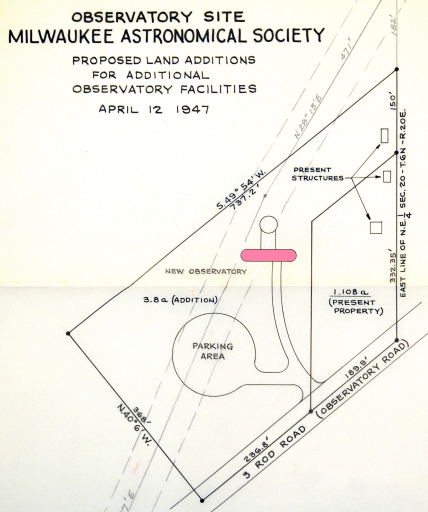
One activity that Albrecht loved was making observatory plans. In 1947 with the pending arrival of Buckstaff's 12.5 inch reflector which he donated and the Luverne Armfield's 10-inch reflector already on hand, Bill Albrecht drew up plans for those telescopes which include a major expansion of the observatory. A big reason for doing this was to protect the observatory from housing encroachment.
3.8 additional acres to be purchased (hopefully donated by the Phillips family) to the west and north, and a new observatory structure with 2 20-foot domes and 2 10-foot domes. The building will feature a large lecture hall, office/library, restrooms, darkroom, a bedroom, and lab on the first floor. In the basement there is a drive-in garage, workshop, storage, and a furnace. Plus there will be roof access. A large parking area would be needed to accommodate the growing membership and visitors.
The grounds layout shown at the left show the original 1.1 acre and the buildings present at that time. You might note that the Tool Shed building was not placed on the property! It is certain that the Phillips farm was okay with this.
The area in pink is what is immediately planned and shown in the diagrams below. The area above it was for future planning which corresponded to the original plan from 1937 where there'd ultimately be an upside down "T" where the big circle is a very large dome with a very large instrument.
The final proposed plans are shown below.
Exterior. Now the plans call for the addition of two smaller (10 foot)
domes for housing smaller instruments. Note the drive-in garage which is in
the basement area.
Basement level containing the garage, storage, work shop, and the
furnace.
Ground level contain the lecture hall, office and library, lab,
restrooms, darkroom, and sleeping quarters.
Roof. Access through a stair case. Note the dome slits are shown as the
same type as the A-Dome.
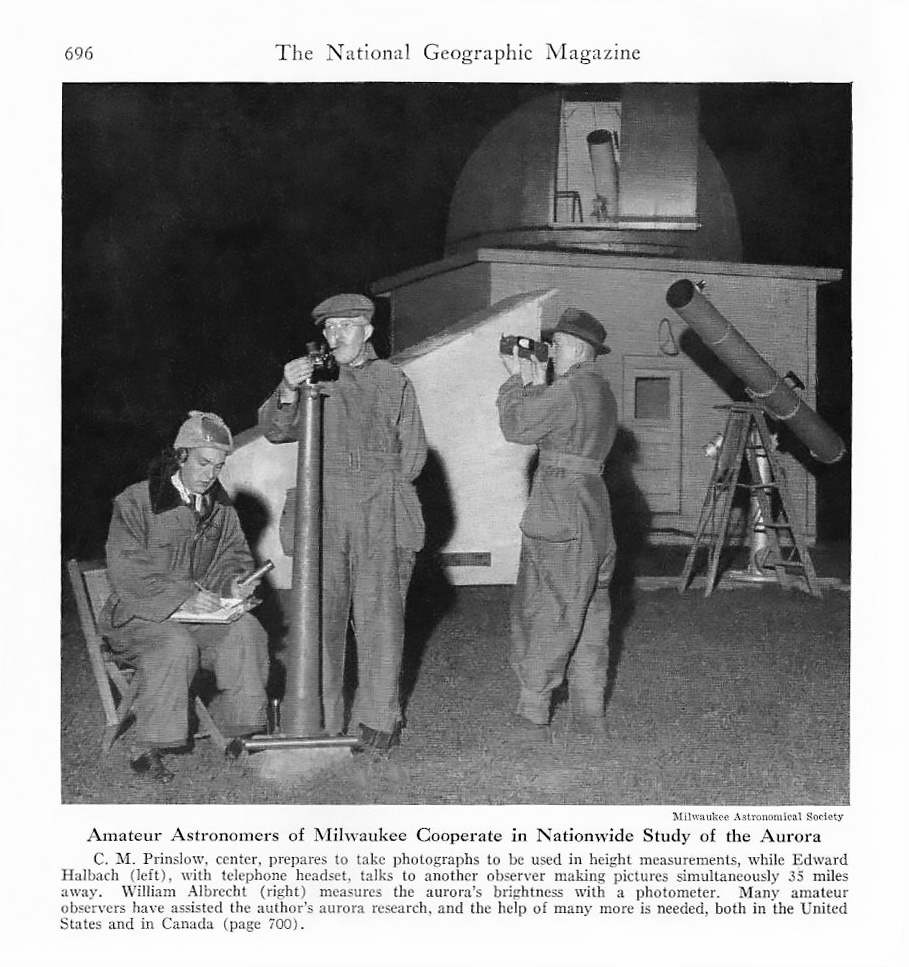 After the war, Albrecht continued the aurora observing.
In 1947, the MAS is featured in an issue of the
National Geographic about auroras. In the article there is a picture of
Albrecht, Ed Halbach, and Cornelis Prinslow at the observatory doing observations of an
aurora.
After the war, Albrecht continued the aurora observing.
In 1947, the MAS is featured in an issue of the
National Geographic about auroras. In the article there is a picture of
Albrecht, Ed Halbach, and Cornelis Prinslow at the observatory doing observations of an
aurora.
By 1949, the plans for the major expansion of the observatory were scrapped, a combination of overly ambitious plans and the additional land not available.
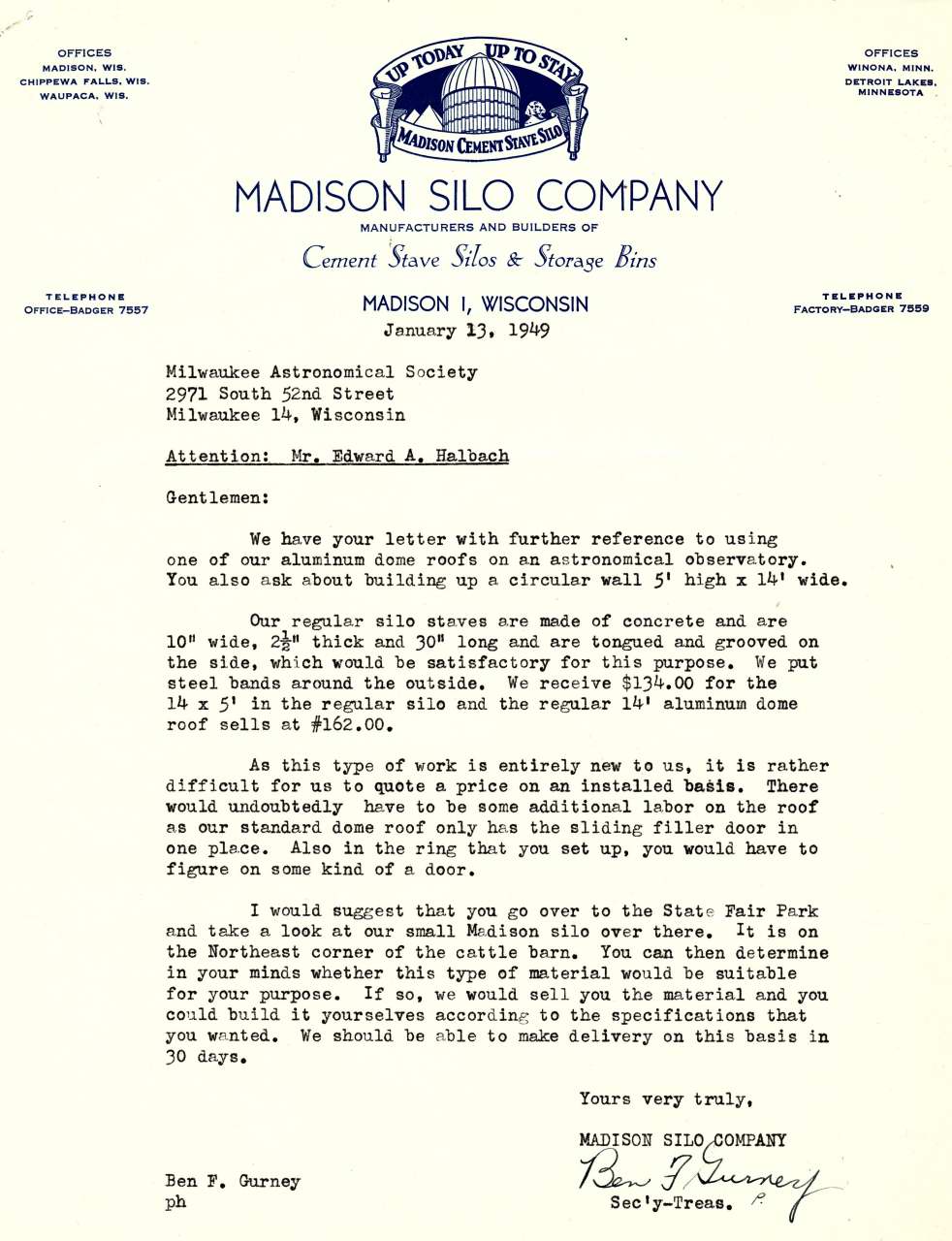
Instead, the expedient and logical solution was building a couple of standalone domed structures for the two telescopes, one of them where there was an existing concrete base and pedestal. Instead of manufacturing the domes ourselves, they investigated buying a commercial product ($700 was quoted with another $700 for the walls) which proved to be too expensive and then the possibility of modifying a commercial farm silo dome. They received a quote of $162 for a 14-foot dome from the Madison Silo Company and $134 for the concrete silo sleeves for a 5-foot tall wall. But even better was the fact that the silo company was willing to help with some of the necessary modifications. Ed Halbach and a few other members made a trip to Winona, MN, where the manufacturing plant was located to advise on the modifications. Albrecht designed and helped manufacture the steel for the base ring and slit.
It was calculated that $1000 was needed to build both structures so an appeal went out to the membership for donations. However, when only $560 was raised, only one observatory could be built.
Thus began the construction of the Buckstaff Observatory (aka B Dome). Ground breaking occurred in the late fall of 1949 and was largely complete (minus the dome slit) the summer of 1951.
His participation was not limited to auroras. He continued with variable star observations and did lunar occultation timings. Also, he participated in many solar eclipse expeditions which took him to some unusual parts of the world.
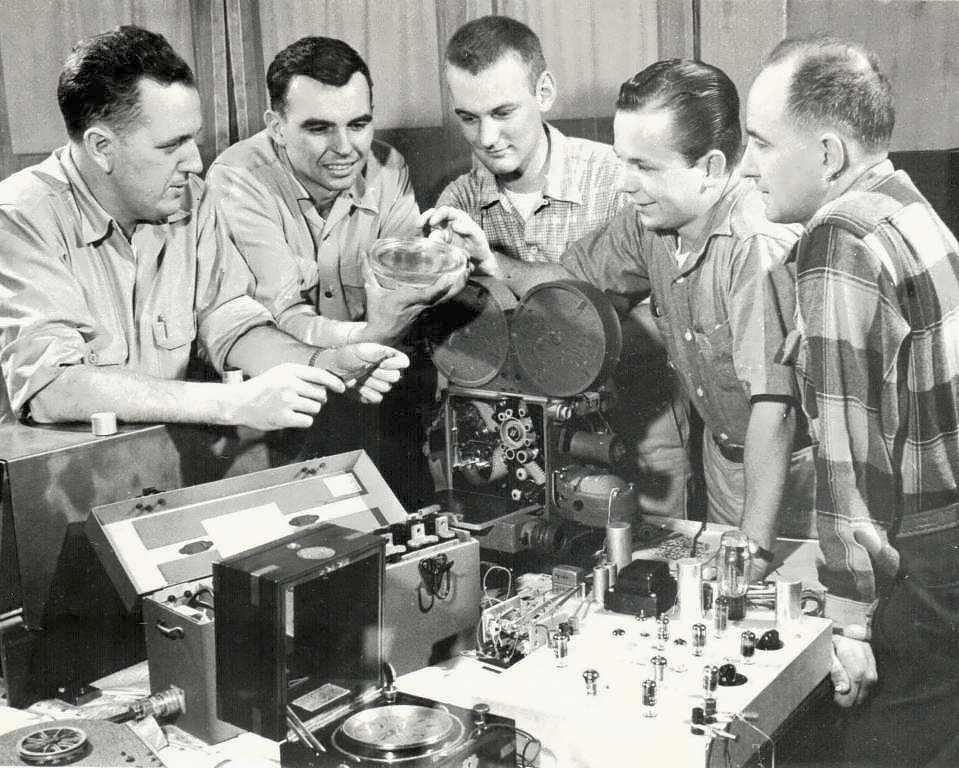
In 1954 Albrecht led a solar eclipse expedition to Mattice, Canada, but unfortunately was clouded out. The expedition crew is shown above, from left: Bill Albrecht, David Knaup, John Neff, Richard Fink, and Bill Konig.
The following year Albrecht participated in a total solar eclipse expedition to Africa.
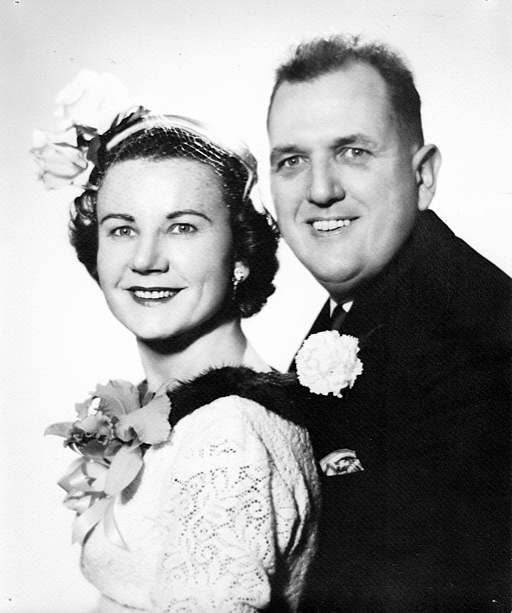 As much of Bill's life involved the observatory, it was only fitting that this is where he met his wife, Anne.
In June of 1958, there was a scheduled tour for a group of hikers from the YWCA and Dick Fink was to host. But Albrecht needed
to substitute. On that day Albrecht met Anne Zwickler. Apparently the attraction was immediate and on December 22nd of that year
in Colorado Springs they got married. As noted in the first issue of the Double Dome newsletter, "Anne saw stars in the sky
and Bill saw them in her eyes."
As much of Bill's life involved the observatory, it was only fitting that this is where he met his wife, Anne.
In June of 1958, there was a scheduled tour for a group of hikers from the YWCA and Dick Fink was to host. But Albrecht needed
to substitute. On that day Albrecht met Anne Zwickler. Apparently the attraction was immediate and on December 22nd of that year
in Colorado Springs they got married. As noted in the first issue of the Double Dome newsletter, "Anne saw stars in the sky
and Bill saw them in her eyes."
Anne later served as the MAS Treasurer for many years and was always at the open house nights.
While employed at Super Steel, Albrecht got to design an observatory dome for the AC Spark Plug division of General Motors (later known as Delco). AC Electronics was building guidance systems for the military and aerospace interests, which would include the Apollo missions to the moon. Basically it was a geodetic device. Super Steel then manufactured the dome in their warehouse at 4th and McKinley. Albrecht noted, "I sneakily designed their dome so that when they were finished using it I could take it down and bring it to the Milwaukee Astronomical Society." However, Albrecht had as cover the practical reality that by building it in three pieces, they could easily get it out of the warehouse and then transported to the site. His reasoning that they wouldn't be using the dome for an extended period because they really only needed it as a Geodetic device.
In 1962 the Wisconsin Sand and Gravel Company offered to buy our observatory
site. The City of New Berlin had made it clear that they want our
observatory moved and both hills leveled. Albrecht, who had already been looking for several
years for a new site, paid for a 45-day
option on a site west of Waukesha on Highway 18. In conjunction, Albrecht also drew
up plans for the new observatory featuring 2 14-foot domes and a satellite lid.
But it also has a lecture hall, office, library, dark room, and bathrooms.
After much talk and many meetings they refused to pay the $60,000 we asked, most of that money for the construction of the proposed observatory. Our refusal to move for less than $60,000 stopped this.
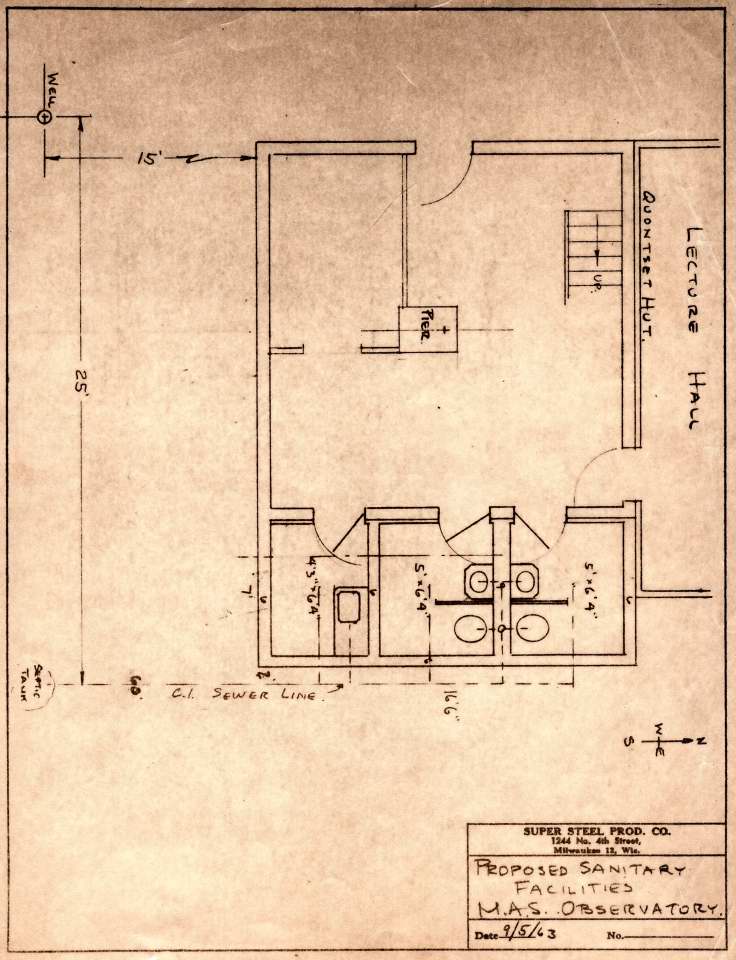 In 1963 after years of negotiations, the MAS was offered as a gift 2 additional acres of adjacent land by Harry Phillips (brother of
M.J.W. Phillips who donated the original 1.1 acres).
In 1963 after years of negotiations, the MAS was offered as a gift 2 additional acres of adjacent land by Harry Phillips (brother of
M.J.W. Phillips who donated the original 1.1 acres).
With the acquisition of additional land which means we'll be staying put on the current property for the foreseeable future, there is a plan plan to install 2 bathrooms and a darkroom by extending the Armfield Observatory to the east. Albrecht draws up the plans on Super Steel stationary. At this time we are still relying on an outhouse.
In December of 1965, Albrecht resigned from Super Steel which had just been bought. He then traveled with Anne and during this time looked for tektites. He found some on the southern coast of Australia.Also in 1965 the club started the Grazing Occultation program with some success. However, after a disappointing graze attempt by 6 observers because of inadequate equipment, Ed Halbach proposed the club build a number of "easily portable" 8-inch or larger reflectors for the grazes and general use, especially at the Open House nights. [From the Nov, 1969 Double Dome] The final design by Halbach and Albrecht was a 10-inch, f/5.6 reflector on a fork mount. Starting in 1970 and not finishing until 1074, the club built 12 of these instruments.
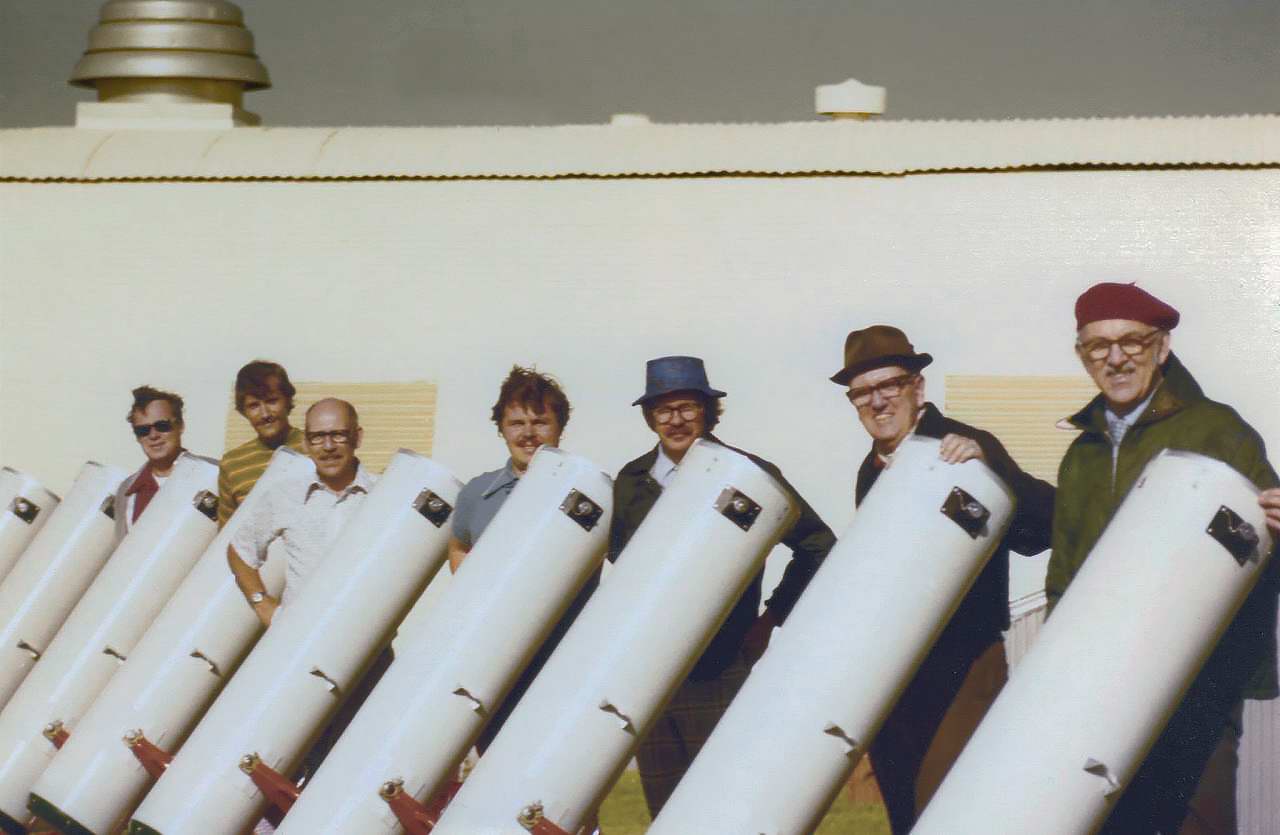
Portascopes. From left: Jim Toeller, Paul Murn, Virgil Tangney, Ken Krahn, Bill Collins, Bill Albrecht, and Ed Halbach.
There were several ideas of what to do with the new telescope and observatory:
1) Build the observatory on a new (much darker) site and move the rest of the observatory to this new location.
2) Build the observatory at a new site, but keep the present site and all the remaining equipment / facilities.
3) Move to a new dark site, but postpone building the 26-inch scope.
4) Don't get a new location. Just build the 26-inch observatory on the present site.
5) Just get an "accessory" site. Don't build the 26-inch at this time. Start the move gradually.
Of the options, #5 was never really taken seriously. But a consensous immerged: if you're going to build a magnificent instrument, it deserves a magnificient site. And to that end no one was more enthusiastic than Albrecht. After a lot of searching, he and Anne, purchased a site about 5 miles west of Holy Hill and offered it as a gift to the MAS for the express purpose to house the 26-inch telescope on that site. Albrecht then designed an observatory with all the needed facilities.
The dome for the 26-inch telescope is a 22-foot structure made out of steel. This is no coincidence. By this time they knew that Delco wasn't using the dome and it's only function was to serve as a roof. The club was sure they could get it donated and they could then use the value of it as a tax deduction.Unfortunately, this proved to be a bridge too far. Only about $10,000 was raised, far short of what was needed. Albrecht would withdraw his offer as the MAS could not use the land for the forseeable future because the land required a $20,000 access road.
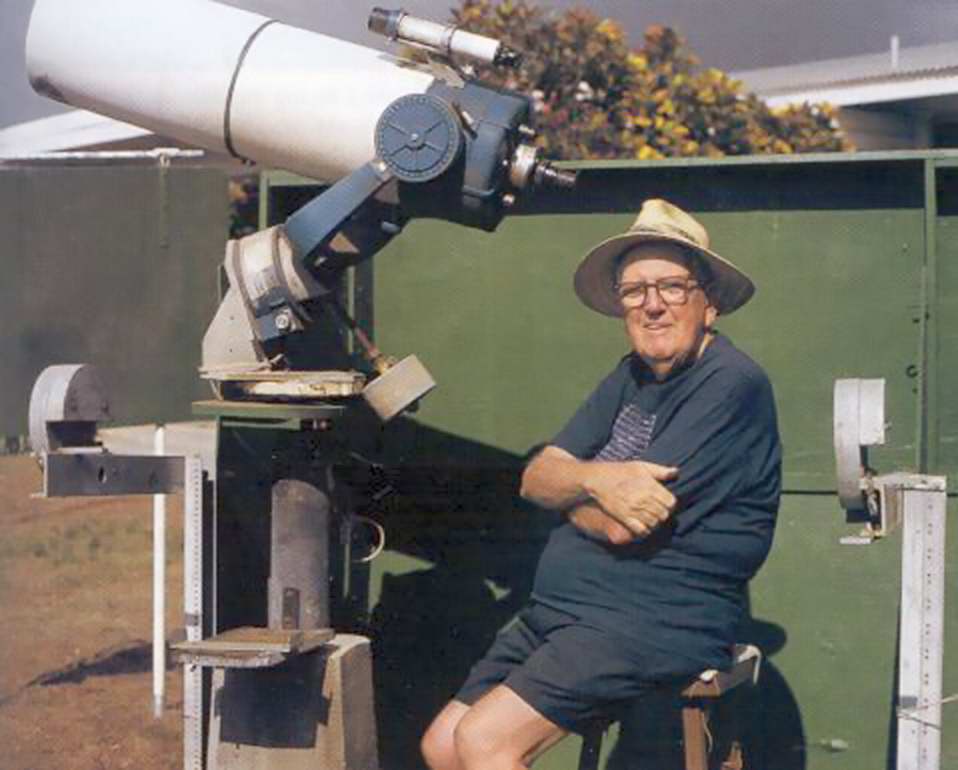 In 1979, Bill and Anne moved to Pahala, HI. Albrecht had an old 11" Celestron (which he used on a mount he built at the MAS Observatory)
set up in his backyard. Because of his
latitude (19 degrees N) Albrecht had to install a wedge and counterweight so he could reach the southern horizon without the
scope hitting the fork. From this location he made over 80,000 variable star observations, working both
with the AAVSO and the RASNZ. Being located in the middle of the ocean, he was often the only observer in position
to make a critical observation. Albrecht did engineering work in support of the CFH observatory and had several
nights per month on a 24" scope on top of Mauna Kea allocated for his personal use. In addition to astronomy, Albrecht spent
much of his time in HI doing volunteer work at the volcano observatory at Kilauea.
In 1979, Bill and Anne moved to Pahala, HI. Albrecht had an old 11" Celestron (which he used on a mount he built at the MAS Observatory)
set up in his backyard. Because of his
latitude (19 degrees N) Albrecht had to install a wedge and counterweight so he could reach the southern horizon without the
scope hitting the fork. From this location he made over 80,000 variable star observations, working both
with the AAVSO and the RASNZ. Being located in the middle of the ocean, he was often the only observer in position
to make a critical observation. Albrecht did engineering work in support of the CFH observatory and had several
nights per month on a 24" scope on top of Mauna Kea allocated for his personal use. In addition to astronomy, Albrecht spent
much of his time in HI doing volunteer work at the volcano observatory at Kilauea.
Albrecht was featured in the January, 1999, issue of Sky and Telescope. The article was entitled, "William Albrecht: in the Twilight Zone." Note: The pages shown are just for basic display. Due to copyright, they have been reduced to a size and resolution where they cannot be read. If you are a member of the MAS, we own a copy of this and it is available for viewing at our observatory.
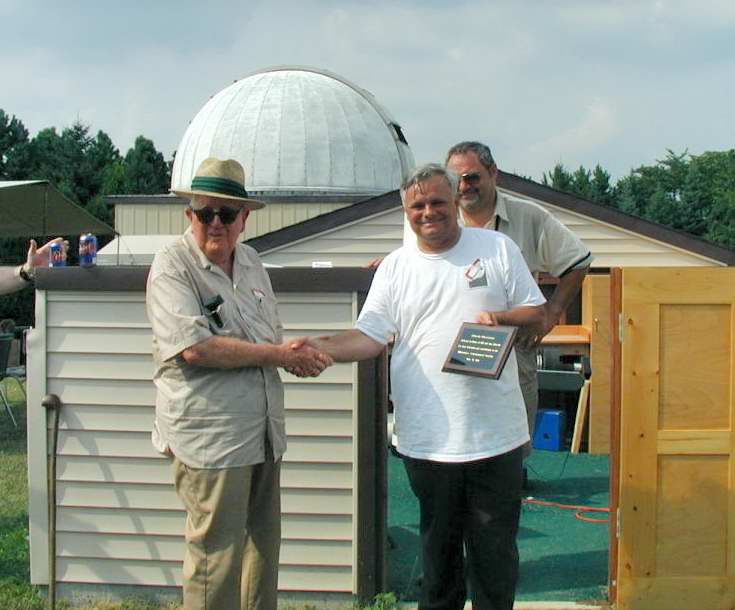 When Anne passed away in 2001 at the age of 84, Albrecht moved back to Wisconsin. At that time, a whole new generation of
MAS members got to know Bill as he attended meetings and picnics. That year the
Albrecht Observatory (located between
the A and B domes) was dedicated to all the service that both Bill and Anne gave to the MAS.
Although that structure was built in 2000, the original pier footing, installed by Bill in 1937, is still in place.
The first picture
of this article shows Albrecht doing that work.
When Anne passed away in 2001 at the age of 84, Albrecht moved back to Wisconsin. At that time, a whole new generation of
MAS members got to know Bill as he attended meetings and picnics. That year the
Albrecht Observatory (located between
the A and B domes) was dedicated to all the service that both Bill and Anne gave to the MAS.
Although that structure was built in 2000, the original pier footing, installed by Bill in 1937, is still in place.
The first picture
of this article shows Albrecht doing that work.
Albrecht donated $1000 to start a fund so the MAS can someday purchase a darker sky observing sight. That fund is now called the Albrecht Fund. It was a long standing dream of Albrecht's to move the observatory because of the encroachment of city lights.
Though Bill participated in all the observing programs of the MAS, his passion was variable star observing and he made over 115,000 observations during his lifetime. For this work he received the AAVSO Director's Award in 2002 and the very prestigious Astronomical League Peltier Award in 1999.
For all of Bill's contributions to the MAS, he was made a Founder Member in 1978.
Bill Albrecht was honored posthumously when in 2014 the IAU named an asteroid after him: (268115) Williamalbrecht = 2004 TK9.

